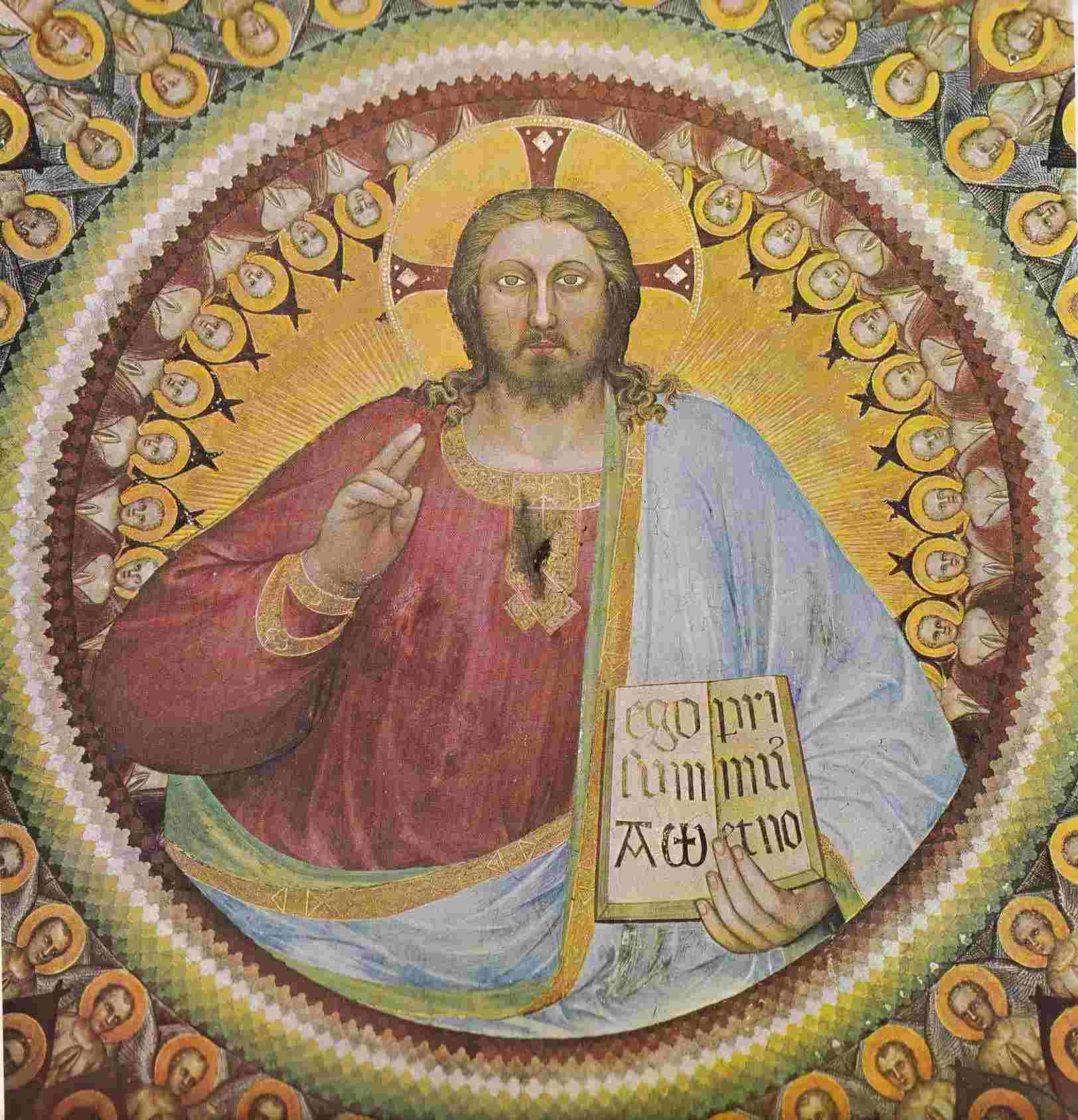
Scan from Fratelli Fabbri Editori, see also this page with this image
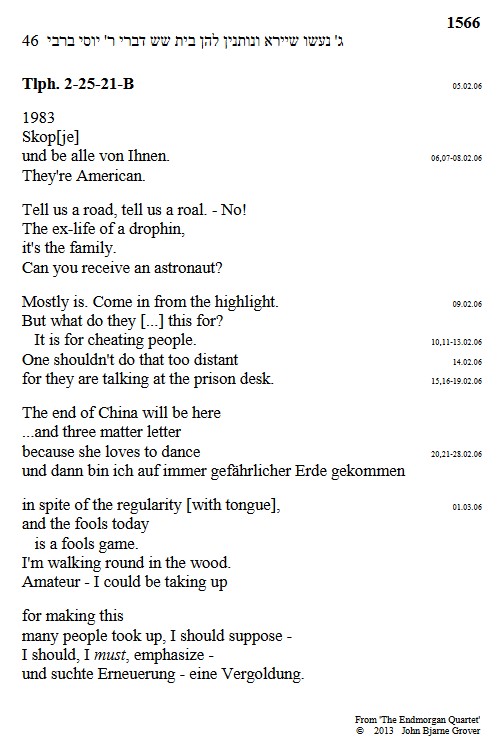
Giusto de' Menabuoi
John Bjarne Grover
The general theoretic background
I wrote "The Endmorgan Quartet" (= 'TEQ') in the years 1997-2008. It is found on the internet as volume 2 in my collected works. It is a work of 1719 poems over 16 books, written on basis of 'inner poetic articulations' which I heard pronounced in my inner mind and which I believe had a 'transcendent' source or origin, in some sense of it. I consider each of the 16 books to constitute what I call a 'poetic function' which interacts with the other 15 functions in such a way that these constitute the human reality - which is a semiotically redundant and limited reality (describable by way of human-conceived causalities and laws of nature) outside of which is a larger reality which humans consider a form of 'chaos' and explore as well as possible through the study of religion and mystic inquiry. Experience has converged on a small number of received world religions which share much of the same conceptual apparatus for the mystic inquiry. My TEQ is, I believe, articulated from outside the main limitations of the human reality and thereby could be considered a variant of 'prophetic language' - which some could consider a format of 'poetic language'. I consider each of the 16 books to constitute one local and one global function - the local function has its scope inside the book itself while the global function has a scope of the 16 books - the entire work in total. The 16 functions of my TEQ are probably not yet seriously described (even if computer-based analyses certainly could exist). I use function 14 as a proof that the work could not have been written on inspiration from administration-controlled intrigue - the function defines a time-based distributional semantics for (in principle) each of the words used in the total work - function 14 is described briefly here. Each of the lines in the work is one single 'inner poetic articulation' (articulated as an acoustic impression in my inner mind) - it had also the general character of being an 'arbitrary unit' in the sense of having to be written down immediately after the inner articulation was experienced, otherwise it would be irretrievably lost after very few seconds (often, say, 2-5 second or so). Each of the lines, written the one after the other, therefore is annotated for date of writing - the handwritten manuscripts are published on this page. It means that each word in the work has a date annotation which can be used for its temporal distribution. I have studied function 14 in some detail - the distribution of at least 50 words - and found that the theory of this distributional semantics has a very good basis for this particular work. The function interacts with the other 15 'poetic functions' and the total work is therefore, from this theoretic viewpoint, to be considered a dense web of interacting 'semiotic functions' which in total constitute the human (semiotic) reality. I use function 14 as a formal proof that the inspiration to this cannot have come from administrative intrigue - but, as I consider a valid inference, must have its origins in a 'transcendent realm'. (There could be dubious administrative interests - such as forms of secret intelligence - out for making claims that my work should have been written on basis of their manipulative intrigues and therefore that they should have some 'copyrights' to it and can use it for example as a template for terror or business or both - such ideas are of course nonsense and can be formally refuted by this function 14).
There seems to be some such 'administrative interests' that could be trying to interfere with my work - an example could be what happened after I had published this article on the relation between Emily Dickinson's work relative to my TEQ - when it seems that somebody has put the source poems of Dickinson out of use on the web - all the links opened the relevant poems when I published it. Another and related story is what I discovered after I had published a study of some works of Ferrari relative to my TEQ that the links to my references to Jastrow's talmudic hebrew dictionary were disrupted by probably removal of the source from the web.
I have made some studies of a correlation of these 16 'poetic functions' with some central works from art history - some examples can be found under the page 'Art relative to my The Endmorgan Quartet' and some discussion of the principle can be found in the article 'Some notes on text and image in 'The Endmorgan Quartet''. I have collected some of my articles on related topics under the page 'Articles on linguistic and semiotic matters'.
The present article discusses the issue whether the work of the important italian 14th century artist Giusto de' Menabuoi can be considered a function of a small fragment (only 35 poems) of the 199-poem TEQ book 16. I have made some similar considerations on Grünewald in the article 'Mathias Grünewald and a global function 12' - wherein it seems that his extant work can be found as relevant to as little as 25 of the 187 poems in TEQ book 12. The general theory on art relative to my 'poetic functions' would be that artists seem to concentrate on one particular function (equivalent to one of my 16 TEQ books) in their total work. Of some interest is my suggestions on the nature of the work of Rembrandt - which would be a special case in view of the idea that as a 'function 7' artist his work seems to converge on an enumeration in terms of base 13 in contrast to the normal base 10 - that is, in accordance with the enumeration of the 1719 poems of my TEQ - an enumeration which I made in the summer 2012 (it could be done in many different ways). But the study of these aspects of Rembrandt's work is still somewhat superficial in its treatment of this interesting theory.
Introduction
Giusto de' Menabuoi (ca. 1320-1391) of the early renaissance - a contemporary of Petrarca, possibly a student of Giotto and a precursor for the main renaissance - seems to be a function 16 artist (by book 16 in my 'The Endmorgan Quartet' = 'TEQ') - more specifically it seems that most of the (at least wellknown) themes of his can be analyzed in terms of one of the 35 poems TEQ #1563-1597 following after the heading with the 'boxed' words 'Leading hand - Farts - Baywatch'. (Boxed words may have a different semantic value than normal words - cp. the phenomenon of 'cartouche' for pharaonic names in ancient Egypt). I was a little hesitant whether it should count as title to only the poem TEQ #1563 or if it should be conceived as a title to the following 'chapter' - up to and including #1597. Clearly if most of Giusto's works can be recognized in these 35 poems, it could count as evidence that these poems constitute a thematic unit. In the following I discuss 8 works of Giusto from the viewpoint of a potential parallel to poems selected from among these 35 poems (TEQ #1563-1597) - including an extra-literary subdivision between Bach III and IV at TEQ #1580-1581. It seems to me the conclusion is that the theory could be seen as convincing - also for the general viewpoint that the esthetic logic of early renaissance Giusto can be seen as highly relevant for my own TEQ book 16.
In the following discussion I also include comparisons with my 23 black-and-white thresholded photos from the Danube Island. It can be assumed that the correlation between Giusto de' Menabuoi's art and my TEQ amounts to an esthetic logic which can be seen as highly relevant for the universalism inherent in these 23 photos - which are taken with a maximal arbitrarity in a grove after completion of my work with TEQ and part 1 of 'Der Dornenstrauch' (= 'DDS') - which means that the logic applies to the phenomenon of presence of a transcendent source in the choices. It can be speculated that this logic could have constituted the beginning of the blossoming of the italian renaissance - and hence it can be hoped that a similar historic development can spring out from the present situation.
The following discussion therefore tries, for each artwork of Giusto I discuss, to find a relevant counterpoint among the poems TEQ #1563-1597 and among the 23 black-and-white photos from the Danube Island.
The images that occur immediately on the screen are kept low in bytesize but better resolutions can be found by clicking links.
An important theoretic background for at least some of the following discussion could be found in the somewhat lengthy (book-length) article 'The fifth dimension'. It is the discussion of some apparent 'ex nihilo' text towards the end of it - the question whether these could be seen as 'generated' by the relevant poetry - which lends explanatory light to some of the following discussion.
Example 1
TEQ #1566 = Paradise - the center of the cupola in the baptistry in the Duomo of Padova
 Scan from Fratelli Fabbri Editori, see also this page with this image |

|
The text that Christ holds in his hand is poorly readable in the reproductions available on the web but is easily readable in the edition of Fratelli Fabbri Editori, from which the reproduction here is scanned:
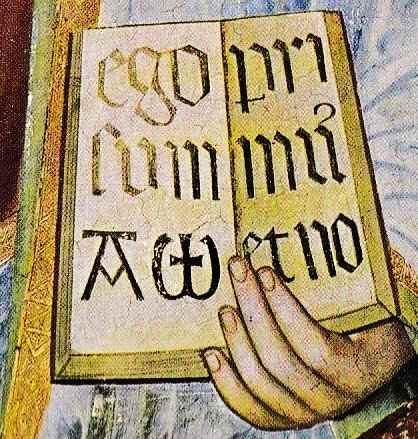
ego pri
sum mu(s)
ΑΩ et no
= 'Ego sum Alpha & Omega - primus et no'. The quote is from Revelation 22:13 - which in the latin translation 'Vulgata' is given as Ego sum alpha et omega, primus et novissimus, principium et finis. Clearly the text of Giusto is the first half of this: "Ego sum alpha et omega, primus et no...".
It seems from my poem TEQ #1566 that this text has the same status as the ex nihilo texts discussed in the end of my article 'The fifth dimension'. It would mean that, in general, 'semantics is nonsense and humbug - but there exist semantics which is not nonsense or humbug - and the Bible is considered that sort of text'. This would be consonant with Giusto's conception such as it can be compared with the ex nihilo formations discussed at the end of my article 'The fifth dimension'.
The title to my poem Tlph.2-25-21-B is seen in the golden bands/ribbons of the red shirt and the fingers of Jesus.
- 'Skopje' = 'Egopri'
- 'alle von Ihnen' - approximates 'a ob du Ihm' while 'summus' = 'top', 'summit' - the word as e.g. summus which could comprise 'alle von Ihnen' underneath the top. The form 'summu' could have been a fourth declension ablative if that 'summus' had existed as a noun, which perhaps it does not but there is also a curl on top of the last 'u' which seems to be a final 's'
- 'The ex-life of a drophin, / it's the family' tells of the omega form, the cross surrounded by 'family'
- 'Mostly is' = 'mu-sum'' - cp. the example of 'harvesting of the most' below - is the most equivalent to vedic SOMA?
Is there a '1983' in the artwork? Could be there are ca. 10-9 (= '19'?) heads inside the righthand side of the circle and appr. 8,3 to the left?
I refer also to the photos associated with some fragments from these parts of TEQ given in chapter 26 at the end of volume 3 - such as photo #5 on page 1227 for this comment on 'cheating people' by the semantics which does not have a complete self-recursive truth a la what is hypothesized for the Bible. Photo #5 refers to this stanza in TEQ #1566.
'The end of China will be here / ...and three matter letter' = 'ΑΩ' - the end of 'Chin-A' is the 'A' and the typography of the Ω = ω consists in three vertical strokes in the letter - with a crossbar on the mid one. The rest of the stanza would be in the crossbars of both Α and Ω.
Photo #8 on page 1228 and photo #13 on the following page 1229 refer to this stanza. This concerns not word semantics but alphabetic letters. It is seen how photo #8 shows the text 'Cafe Europa' which associates somewhat with 'Alpha et Omega', while #13 shows a bottle of 'Eristoff Ice' (a vodka, it seems) which here applies to the letters of 'et no' by 'E[r]-ICE-t-off' (by 'off' = 'no') - for that third horizontal row in the text held in the hand of Christ in Giusto's artwork.
The following two photos #14 and #15 completes the poem TEQ #1566 and its conception of semantics. #15 is that fool's game when the soap (or is it 'swap'?) container looks like a laughing face - cp. also Giusto's 'Baptism of Christ' (next example). The harnessed horsehead in #14 emerges from the melted snow on the scattered tree bark. Why is heat emitted just there? "...for making this / many people took up, I should suppose - / I should, I must, emphasize" tells of a bodily movement like washing the hands by rotating a soap in the palm while searching for the golden filling in the mirror. It would be the same bodily feeling as for 'Tennison dived under the water to dive for drinking water'. Hence the language - which can be thought of as not humbug - will here for Giusto lead to the experience of the body of Christ in the language.
'Eine Erneuerung - eine Vergoldung' is what is told in the title line of TEQ #1566 - hence the end and the beginning.
This suggests that the basis for the text in the hand of Christ in Giusto's artwork has a motivation in the lines of my TEQ #1566 in a way resembling the motivation for the apparent 'ex nihilo' labels and text discussed at the end of the article 'The fifth dimension'. This suggests that this poem is relevant for this artwork of Giusto.
If a comparison with the 23 black-and-white photos is sought it is noticed that the only of the 23 photos which has an encoding of an alphabetic letter is the last photo #23 where one can see the outlines of what looks like alphabetic lettering on the landscape - notably 'φωσ-STA'. Whether one also can find traces of the alphabetic letters in Giusto's work I dont know. Could be the φωσ could look like 'ego'.
Example 2
TEQ #1575 = The baptism of Christ:
|
|
|
'[...] itself a static' seems to tell that it is not John the Baptist who pours the cup of water from over the head of Jesus - this cup of water is immovable while the rest of the world turns around it - like Newton's apple can be seen as static while the world hops up due to the gravitational ('børa') attraction in the apple mass. The turnaround could be seen as present in the artwork by the three stages of the water container - on top of the head, 90 degrees on the side and 180 degrees in the large cup-shaped semicircle.
The Mesorah edition of Talmud Bavli Erubin translates the hebrew parallel as follows: "Three [people] constitute a caravan and we allow them six beis se'ah" (a 'beis se'ah' is appr 625 square metres) - which could be understood as the 'holy people' on the image - Jesus, John and God above - and six human beings on the ground if two on either side are counted. My own clumsy word-by-word lookup could construct: "3 Esau - himself, parent and teaching himself - towards them to pass the night on white linen/marble" (notice the hairy clothes of the baptist) - which could be telling more about how 3 'Esau' concern himself, his father in heaven and the baptist teaching him - relative to those who hold his clothes, the textiles in the image (same colour as for the divine above) - and could be in such a way that the annotated white semicircles are present in these aspects. Could be this means that the 'børa/bøna' = 'burdens/prayers/beans' are scrambled for the case of Jesus (and the baptist) - both divine and human. The new things are then what comes from the father in heaven via these human relations.
'It's very dansk' = 'it's very danish'. This could seem a little cryptic - but maybe it could be argued that the baptist has a certain 'danish look'?
If a correlate among the 23 photos be sought, it seems that photo #17 is relevant:
|
This has a 'triptyk' character which invokes the idea of a home environment - to the right the TV screen with some formal program on, in the middle a man is seated in a sofa watching this TV screen (his attention half consumed by the screen) while just in the process of unscrewing a bottle of some drink while the son is holding a wooden toy horse head over him (or next to his cheek) from behind the sofa, and to the left the wife is naked on the upper body with a small child on her lap. The relevance of this for Giusto is seen in the two persons to the left holding some clothes which are off for Jesus, in the middle there is a dove (here horsehead) above Jesus while the 'drink' would be the role of the baptist, whose role would then have been merged with Jesus. The photo can also be turned 90 degrees (TV screen on top) in which case the white diagonal would be the arm of the baptist and several elements from Giusto can be spotted.
More relevant for my poem is the presence of 'Denmark' ('very dansk') on the map:
|
One sees how 'Sjælland' (with Copenhagen) overlaps the TV screen like the man's face does. Denmark looks like an old person or mythological gnome of some sort carrying a sack on the back - here 'børa' - which is not the same as 'bøna' = 'the prayers': These prayers could be seen in the diagonal going down right (crossing over 'Copenhagen') from before the face of the 'gnome' or old person, or from the face of the man, or from the face of the wooden horse - in fact from about 'the chin' = 'hagen' of each of them. They share this venue of pronounced prayer - like a 'co-pen'? Then 'bøna' = 'the prayers' are 'scrambled' - here like the meetingplace in the baptism of God, Jesus and the baptist in Giusto's artwork. Cp. also the title 'If you're going to København' on my TEQ book 14. The 'børa' could be seen as scrambled by the 'burden' on the back of the man - the wooden horse. Interestingly, the phonological classes of 'r' and 'n' could also be seen as scrambled - for the 'børa/bøna'.
But maybe some would have seen the map differently - as for Laholm and Malmö being comprised under the extended area overlapping the screen. But notice that Gothenburg would be approximately in the eye of the man who watches the TV screen. Cp. also the diagonal 'stream' (pronouncing the creation of Adam) in photo #20 discussed under example 10 below. It is seen how this 'danish' on the map adds the 180 degrees rotation to the 'static' baptism - in which case the boy's wooden horse held over the back of the sofa in my photo could be more like the cup of the baptist.
Example 3
TEQ #1588. "La mietatura e la vendemmia del mosto" - 'the harvesting of the harvest of the most' ('most' = vedic 'SOMA'?). Reproduction from the edition of Fratelli Fabbri Editori - tells that it is an excerpt from the baptistry in the Duomo of Padova:
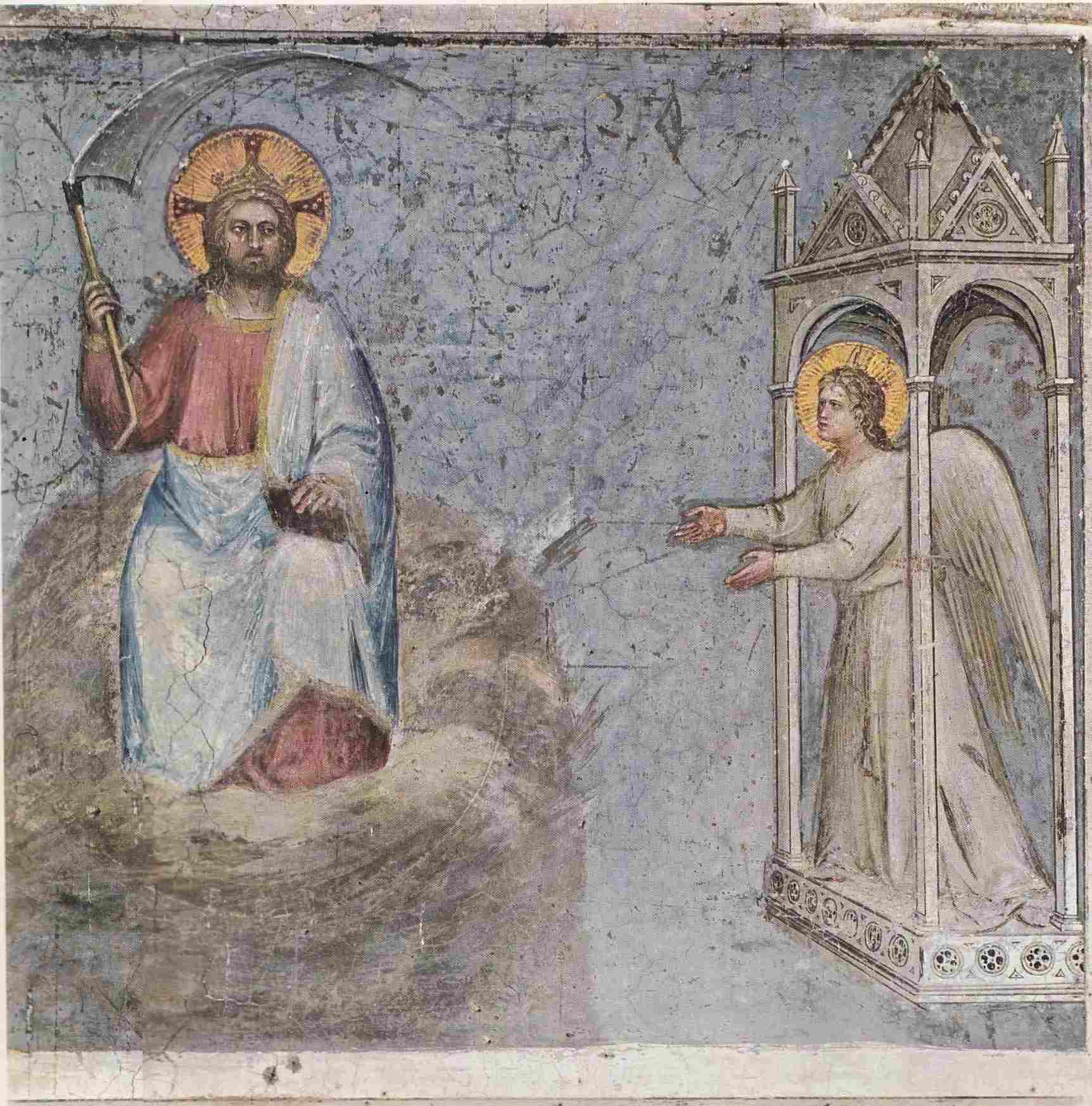
|
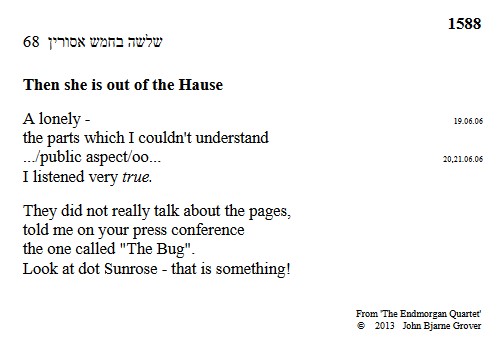
|
My poem TEQ #1588 tells that the confinement in the 'Hause' is the confinement in what is publically available of knowledge while the transcendent knowledge is found outside this confinement - and the transcendent knowledge is conceived in form of the harvested most - which probably is an idea akin to the SOMA (cp. 'Sunrose'?) of vedic philosophy. In modern postwar society the ideas could resemble what is publically available knowledge vs the 'classified' most. Here it is seen how the golden border along the blue coat of the Paradise motive (example 1) is turned 180 degrees in the similar form of the scythe. 'They did not really talk about the pages' - like for 'a, ob du Ihm', it is not really the inside pages that are referred to, even if these clearly have an important role to play. I did not pick up this possibly ex nihilo item since I thought that it could have been somebody else who had kept it for an amulet function and it had fallen out of a handbag and the owner could have come back to search for it. But clearly some intelligence service or something like that could have followed me on surveillance and sent an envoy to pick it up - and then the inside pages could have been available in the sense of classified truth. Then on the press conference presenting the precious knowledge they could have felt justified by philosophies a la Giusto here. It must be observed that 'press conference' perhaps rather could refer to a fruit press, while the Sunrose should have been understood in terms of a 'Sobibor' jewish mystery of truly transcendent character - not in that sense of secrets of administration. This 'Sobibor' is what I experienced in the summer 2015 while I was in a hotel in Szolnok - a high drill (say, 5-10 metres or so) outside the hotel was going constantly up and down while rotating quickly around (the drill was unattended, it seemed - but rotating and going up and down for about 3 days or so) while indoors the nights were filled with loud sobs from a room in the neighbourhood - so loud that I had to sleep with sound protection and windows closed - the loud sobs or groans went constantly for an hour perhaps, then silence for a half or a few hours, then loud sobs for another hour or two. The rotating drill would here be in Giusto's circular glory while the up and down would be in that form of the scythe - its handle and blade - while the sobs would be in the 'fruit press' of the 'Hause'. The 'Sunrose' could then be the moment of resurrection of Christ - in the moment when he is just about to wake up in the tomb - cp. the 'Götterfrucht' label discussed in this article.
There is also a strong relevance for this work of Giusto in my photo #15 from the 23 thresholded photos from the Danube Island:
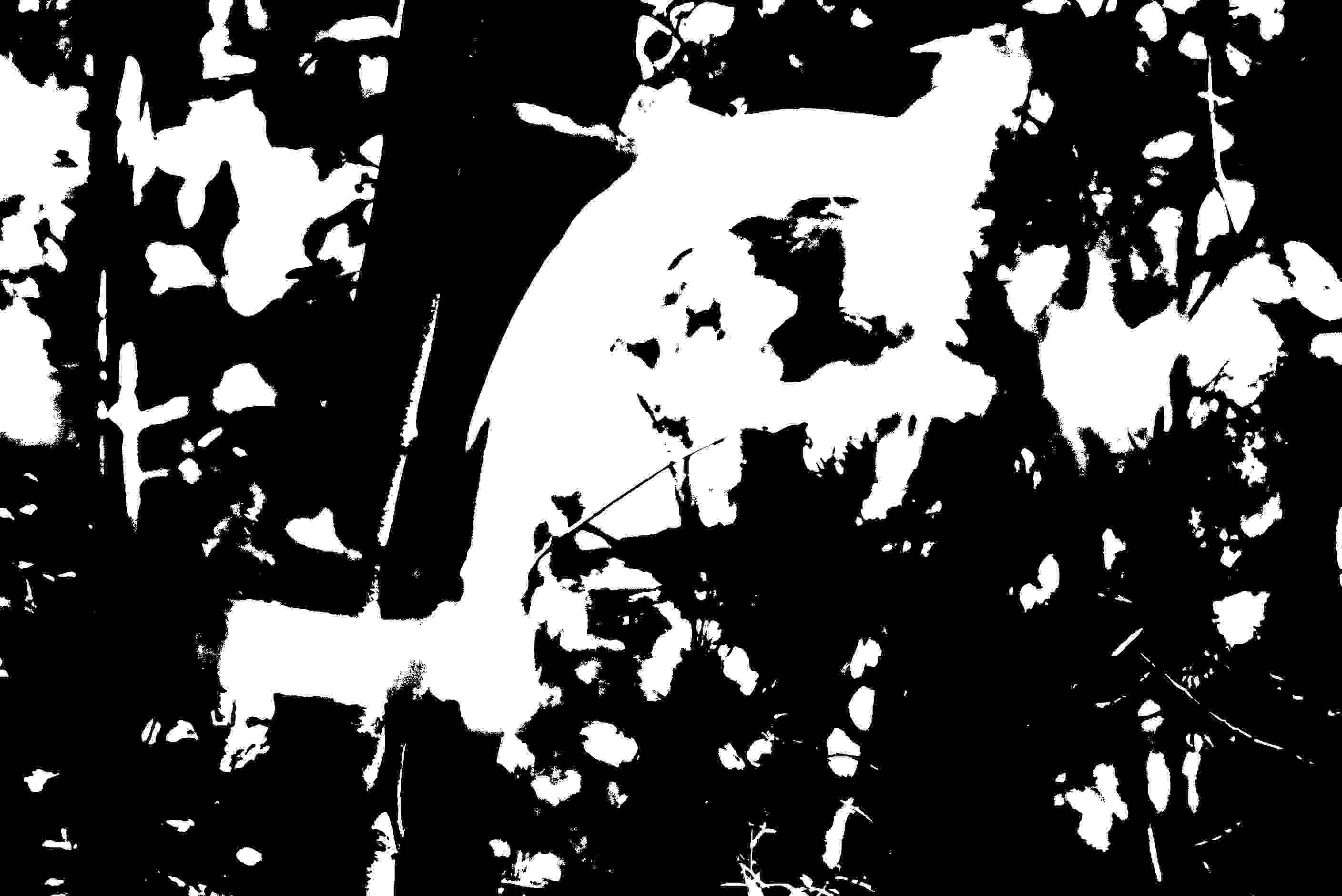
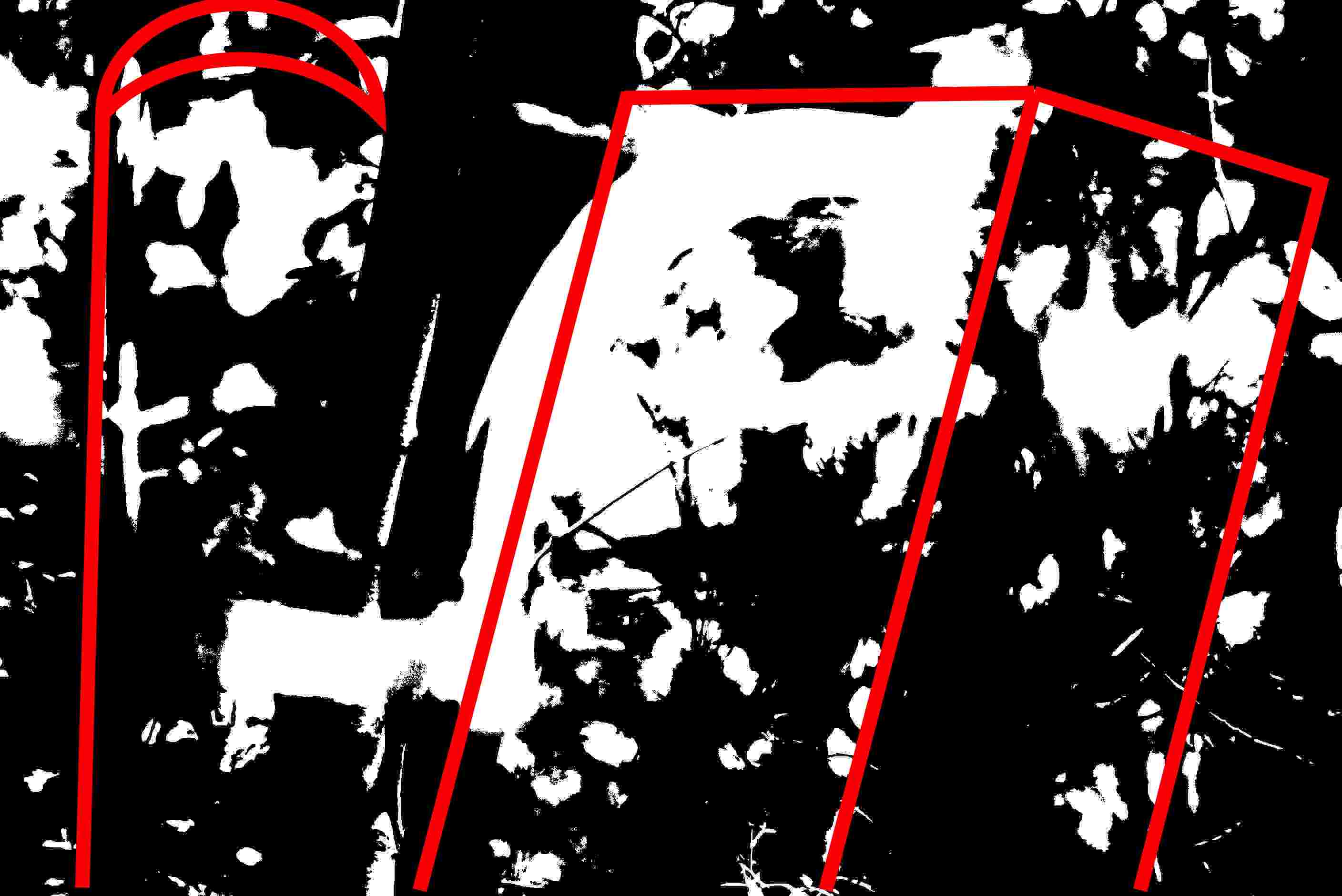

Example 4
TEQ #1593 = Giusto's "Three wise men" (6,1 MB):
|
|
The artwork shows the arrival of the three wise men (the three kings) who present their gifts - the one at the Jesus child seems to present probably a censer with ceremonial incense - when this is opened it creates an isomorphic structure to the right including the landscape they had travelled through - and the guiding star is seen up to the left of the tower or castle on top of the mountain. Inside the isomorphic structure to the right there is a 'composite' person - apparently a servant of another of the three wise men - he seems to leap forwards and is composed of his own head and parts from the body of the following wise man. His arm is backwards-thrown, though, like Jesus on the cross at the other end of his earthen life. This role of the head could be recognized as a 'man-on-wagon', could be relating to the last line in my poem. This leaping character has an isomorphic correlate to the left of what is inside the censer - and hence could also relate the olfactory sense to the other senses - it would mean that the incense in the censer is the composite person to the right - and this composite person imitates aspects of (is isomorphic with) the Jesus child. My poem tells that for the three arriving kings presenting their gifts, the light is defined by the air and that is why they present this incense - and the cost is that 'fragmentarium' of the 'composite' person who constitutes the throng isomorphically. It is also possible to think that the gifts were a cost - this one could be seen as having a reflex in the crucifixion. This has correlates also in the group to the left - and it is told in the poem that this indefinite 'de-lecta' (reducing a double truth value to one?) means a 'wellness' without 'quality' - could be via isomorphism instead. ('Bestemt' is norwegian for 'decided'). It seems that my poem can be seen as relevant to most parts of this artwork of Giusto.
This analysis finds an interpretation in photo 13 in my 23 black-and-white thresholded photos from the Danube Island - here annotated for showing the partwise relevance:
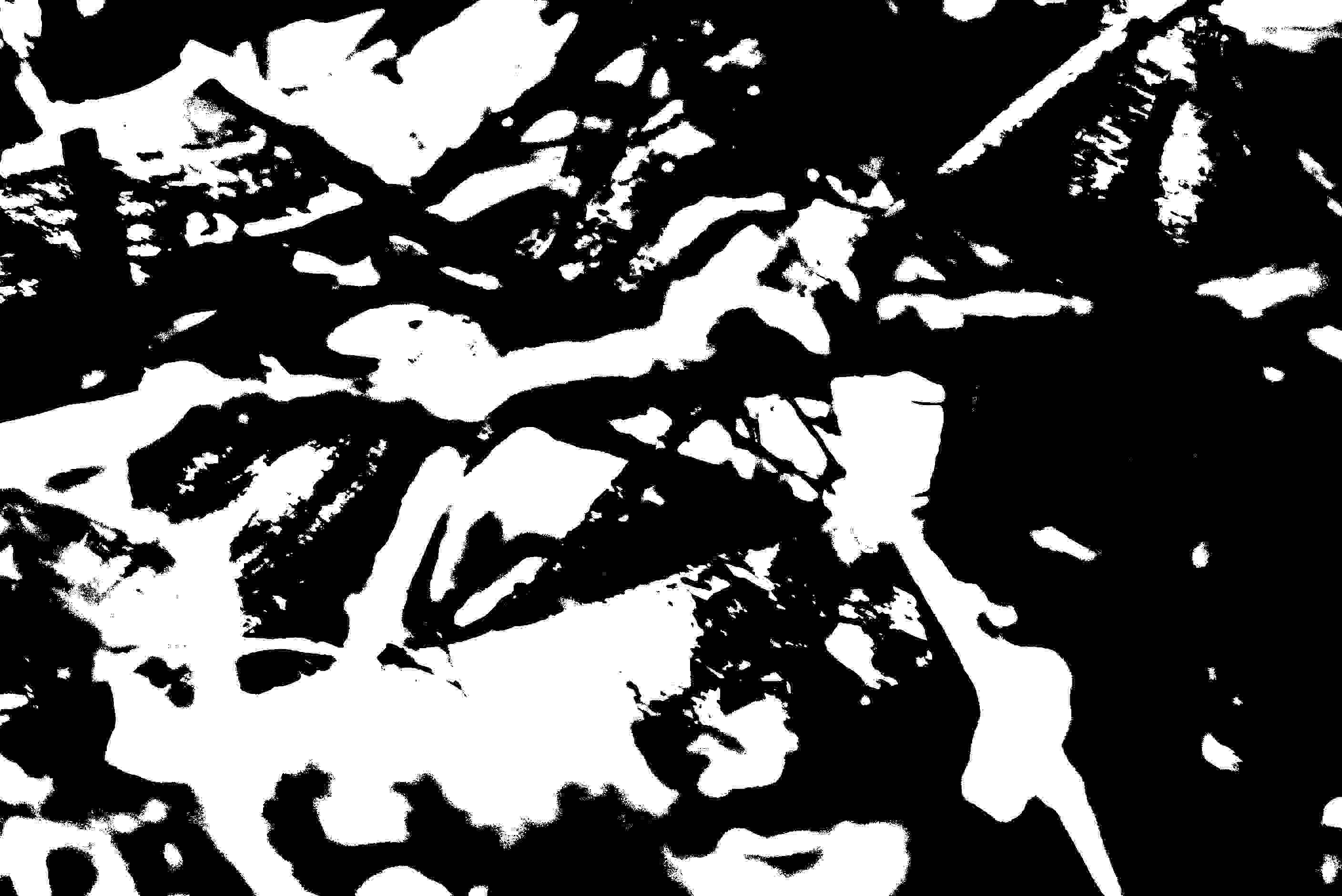
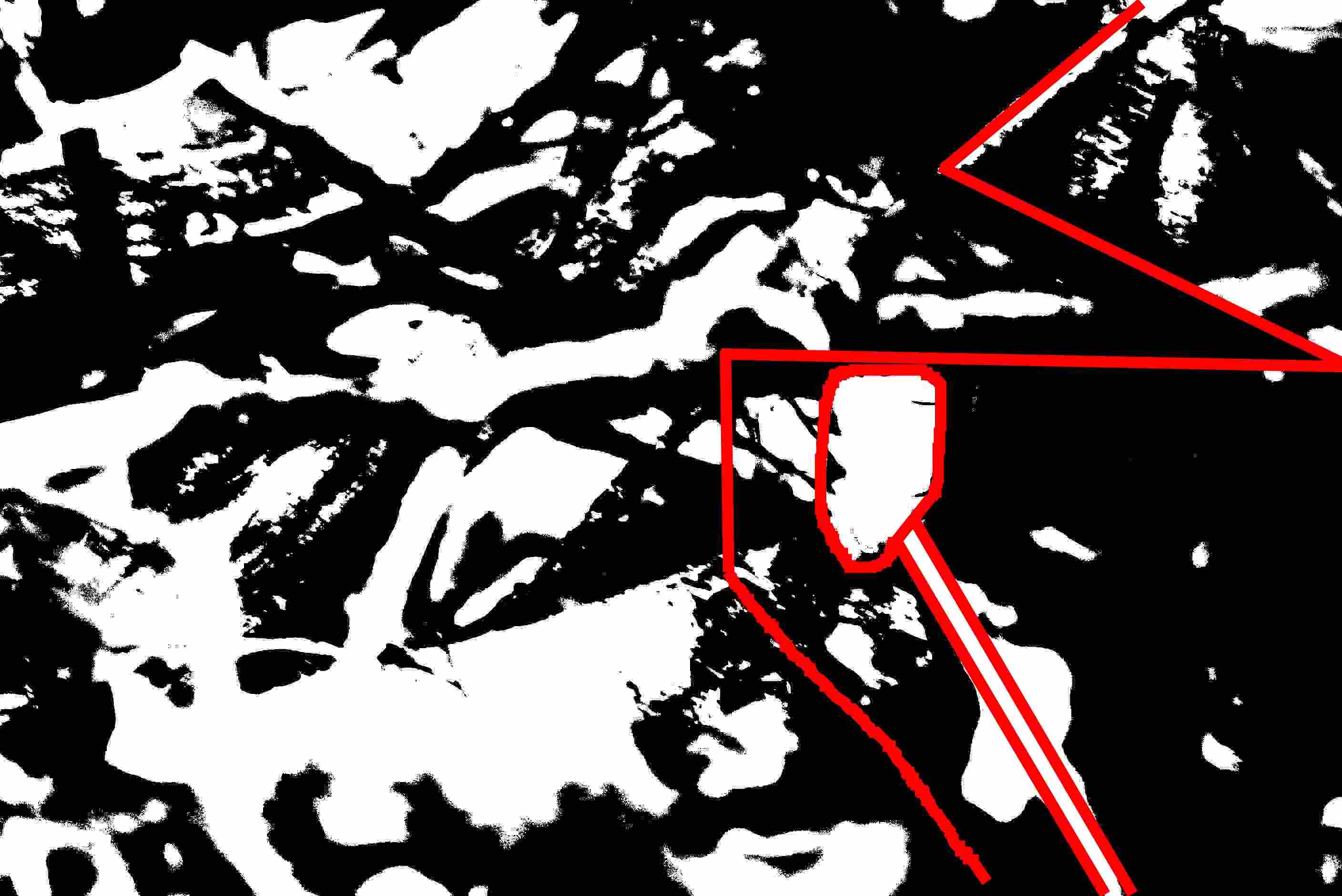
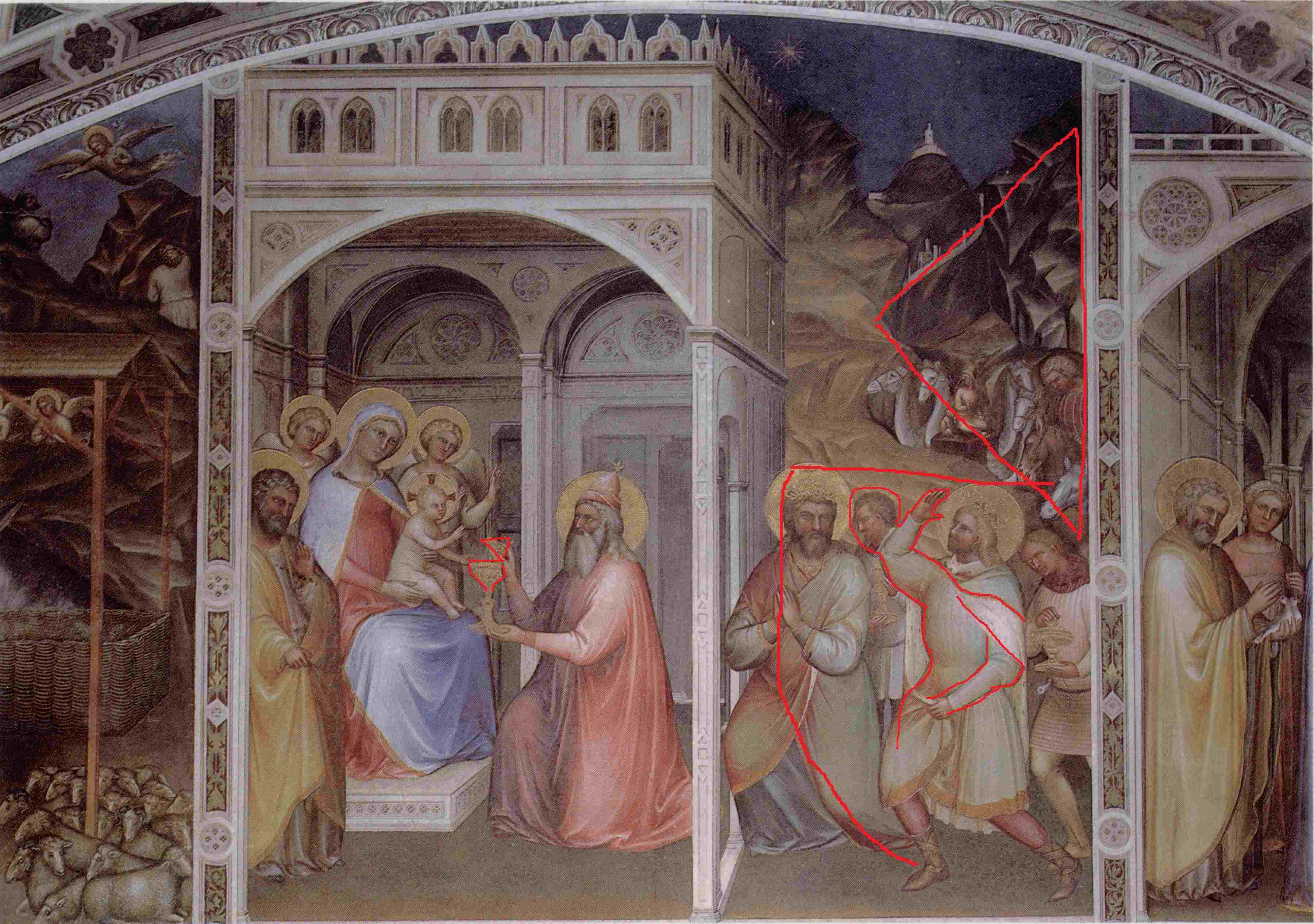
One sees how the big triangle in the upper right and the 'group' underneath with the 'composite' person inside matches Giusto's work - and then the lefthand part of my photo shows the 'kiss' of the olfactory bulb underneath the 'burning raft' up left which corresponds to the 'baldachin' under which the family group is situated in Giusto's work. There is a rather direct line going through the three gifts in Giusto's work and this corresponds to the horizontal line which could be extended leftwards to the 'kiss' of the olfactory bulb in my photo. If the line along the upper part of the group to the right in Giusto's work is extended leftwards it would probably 'kiss' the olfactory region of the Jesus child.
An interesting observation on the phenomenon of this photo #13 being used also for example 8 discussed below: There the same white diagonal is a rolled-up sail which here amounts to the 'composite' fragmentarium person in Giusto's artwork. See 'DDS II:18' and the two end lines of that poem DDS II:18:
Das einzige, das in der Regel ist,
ist in den Dialekten, die ein Segel ist.
This would here explain the line 'How necessary it is!' in my TEQ #1593 - since it is a 'Regel' - and the disciples had to 'confess' this to Jesus on land. The necessary regularity would correspond to a strong redundancy in the human reality - but Jesus has here demonstrated the only relative necessity by the miraculous catch of the fish.
Example 5
TEQ #1591. Giusto's "Annunciation" (from https://en.wikipedia.org/wiki/Padua_Baptistery):
|
|
|
There is a notable similarity with my photo #3 when turned upside down from the Danube island 23 photos - those are 23 photos totally arbitrarily taken in a grove - lots
of greenary only - which I later thresholded to black-and-white. This photo #3 (upside down) comprises Giusto's 'Annunciation' in the righthand side, and to see if even the lefthand side of my black-and-white-thresholded photo (upside down) is present in the context to Giusto's artwork, I searched the web and found a larger excerpt from which I reproduce the following screenshot along with my photo 3 upside down:
|
|
|
The large female nipple in front of the 'shooter' in my thresholded photo corresponds to the corridor in Giusto's artwork. Is there a window (Fenster) in the wall between the two chapels? Could be that window really is the corridor - under which the angel is 'counting'. And hence the two chapels are really 'fully isolated' - although they 'agree' and therefore are conjoined into one (like 'united states') as in the human conception of two metaphysical units as one - wherein the difference possesses an incomprehensible quality like the birds appear incomprehensible to humans - with wings like angels. This bird flies through the 'Fenster' - like seen to the left of the scene when the curved upper frame of the window corresponds to the second 'bird' in my black-and-white photo - this bird (of the 'law of the window') is white where the one that goes through the wall and reaches the virgin is black. This leftmost window has a correlate in a second corridor - likewise with a curved upper frame - between the window and the angel. The big 'axe' to the left in my photo likewise has correlates in Giusto: Who are Ego Fender and Gustav Forbeck? The ego fender couldbe the white semiwall under the curved window to the left - as one half of the double axe - while Gustav Forbeck is then likely to be the man in the door opening, reaching his hands forth (see also example 3 above) - as the other half of the double-edged axe. Or, as this larger excerpt (from this larger view at the fresco on this page) can suggest, the double axe (or 'sledgehammer') to the left of my thresholded photo could be about the stairs or who are on the stairs in Giusto's fresco.
The remarkable esthetic-logical correlation between Giusto and my photo finds its origins in the complete arbitrarity in the original photo (upside down) - that means in my semiotic model the arbitrarity 1 which is under 'divine control' - beyond the control of the human consciousness.
Example 6
TEQ #1563. Giusto's "Wedding in Cana" (on this page):
|
|
|
A notable aspect of this artwork is the peculiar perspective that seems to originate from the fact that the openings of the water containers are too close compared with their lower diameters. How can it be explained? That is possible only by way of a per-spective that seems to consist in the light of the eye reaching the containers like the water that flows out from one of them. There seems to be a special white light on top of the containers and along their handles. It seems that the scene can be compared with the 'Annunciation' via DDS IV:3 the third poem in the fourth part 'Die Schönheit der Welt' in my 'Der Dornenstrauch' - from which it is seen that the water that is poured from over the shoulder corresponds to the 'tiefere Intention' if the water is the own vision. 'He is will come back'. The white light on top of the containers is the snow in my poem. This explains how the water is turned into wine - it is the same phenomenon as the immaculate conception of the virgin. The second stanza in my poem tells of the drink and food on the wedding table.
The flowing water being the same as the vision is the 'Baywatch' in the title to my poem.
The special perspective that is created from the disproportion of the large diameters of the water containers relative to their tightly positioned openings I observed also in a print I found on the internet some years ago (but which I cannot find again now) - a reproduction of Eva Xiuxia Jing's 'Kinesiske krukker' = 'chinese jugs/jars/water-containers'. The disproportional diametres are shown in the lower right along with the remnants of the cross of Christ inside his glory of Giusto - and the form associates with this pouring jug of Giusto. It seems the lower right element shows the semiotic aspects which characterize also the artwork of Giusto.
By my TEQ #1563, the belief of time is a film wherein the film 'Believe' occurs at a certain point of serial time, thereby perhaps exemplifying the nature of phrase structure grammar, and the will has come back like the container from which the water flows. It looks in fact like a swimming pool - the four people on the floor (just in front of the pouring jug) appear like swimming around in water. Looks like in a bay of water - hence the 'Baywatch'.
Is the story of England really in opposition to the 'latin' more than strictly speaking the 'catholic'? Is it about 'milk' in 'lat-in' vs the territory of 'landen'?
It is noticed that - in addition to Jesus - along the lefthand row at the table (the males) only those who are in the process of eating or drinking (like the stanza 2 in my DDS IV:3) are equipped with glories - these are apparently the ones with correlates in 'swimmers' in the middle of the room.
The man next to Jesus seems to mirror his movements - like by a 'Leading hand'. The water pouring from the jug is guided by a 'leading hand'.
The hebrew goes, by the Mesorah translation: "What, then, is [the difference] between an individual and a caravan?" A word-by-word suggestion could concern the form "something to penetrate / split / reflect upon, chosen towards parent".
The riddle is: How could Jesus make the water turn into wine?
Is there a black-and-white photo for this 'Wedding in Cana'? Could be the most interesting one would be in photo #22 - one sees the two 'swimmers' and the outlines of a 'bulby' redundancy which could contain some information. However, more interesting is the photo #22 when turned upside-down - then one spots the outlines of a female face carrying a mask - could be a nurse in a hospital - who walks leftwards and seems to carry some load in her arms - and it seems from her wrinkled forehead that she suddenly has become aware of something up in some distance which attracts her attention - could be in a slightly worrying way:
|
|
|
What is it that she spots inside the encircled field? Is it a couple in bed - under a shower-like form? It is when one consults the biblical story of Jesus in the wedding in Cana (the gospel of John chapter 2) that one can see the relevance of this for the work of Giusto. It is found when consulting the greek for John 2:4: This contains the word ὥρα = season (of the year), year, hour, the right time, blossoming time. However, this ὥρα = 'hora' is with aspiration (glottal friction) of the initial omega - had it been without initial aspiration it would have been another word - ὤρα = Sorge, Vorsorge, Besorgnis = 'care' - such as this role of the mother of Jesus present in the wedding. This fragment from Frisk's greek etymological dictionary contains also the ὀλίγ-ωρος = 'wenig Sorge tragend' which hence can be recognized in the upside-down black-and-white photo in the detail of the woman with wrinkled forehead apparently carrying something in her arms = ὤρα = 'Sorge tragend', carrying something for which she has the care or responsibility. John 2:8 refers to the 'ἀρχιτρίκλινος' which means 'master of three beds' in the sense of the 'master of the feast':
ἀρχος = 1) verbal noun from ἀρχη = beginning, origin, Herrschaft, chief, government, and 2) rectum, Mastdarm, After.
κλίνος = (sich) neigen, (an)lehnen, (sich) senken, beugen = to bend over - like that shower-like construction over the apparent couple in bed - the encircled area which seems to attract the woman's attention in photo #22 upside down
John 2:8 uses also the word αντλήσατε = 'draw out' (imperative 2ppl) for the drawing of water. It is a verbal formation from
ἄντλος = Schiffsbodenwasser, Kielwasser - in general 1) the hold of a ship (hold = space below deck where the cargo is stored), or 2) the bilge-water therein whereby 'bilge' can mean either the lowest interior point of a ship, or the exterior part on which a ship rests if it is drawn aground. Hence an inherent allusion to ideas of the link between the 'inner and outer' - such as, I would notice, 'poetic articulations'. A 'bilge' can also mean 'the belly of a cask/barrel'. (A 'hold' can apparently also mean 'higher yeoman, owner of allodial land').
One guesses that this complex could be a playground for political mythology - such as the ones who try to claim that people have let out 'flatulences' by which they could mean simply that the pronounciation has been aspirated for which reason 'ὥρα' instead of the unaspirated 'ὤρα'. Would this even be the views of the philosophers who try to make an identity between flatulences and marital infidelity? It could even be about those political views which could aspire towards claiming that poetry = wine and that is not the same as ordinary water - but by clever intrigue it could be possible to turn ordinary water into wine - and those who can accomplish that could feel that they could be in charge of divine authority. It is noticed that the difference
ὥρα vs. ὤρα = / vs. \
and hence comes down to the difference noticed in the article 'The two petrification points' between 'having a great desire for granting heavens' (= 'Messiah') vs. 'having a great desire for granting terror' (= 'Hitler'). Such a demagogic trick could find its ultimate origins in an abuse of the phenomenon which I describe in the notice 'Derivation: How language relates to logic' - and could harvest illegitimate public support for terror-based strategies from a diffuse human feeling that 'logic is inhuman and ignores our feelings'.
For the present discussion, though, it is mainly this 'leaning over' of the shower-like form attracting the attention of the forehead-wrinkled (knitbrow?) woman who seems to carry a 'care-mask' of some sort that is of interest for the relation to the work of Giusto - which clearly could be interpreting just John chapter 2. On a closer look, though, it may be that the woman with the wrinkled forehead is not really having her attention to what is under the bent shower-like form - but maybe something higher up. Notice that it is the man next to the woman with the glory on the corner between the two tables who seems to have some strange mark on his forehead - if that be on the original fresco of Giusto and has not been added later. I notice also the corresponding puzzling 'dirt' on the innermost ('heart') of Christ in the 'Paradise' work: It looks not like an 'immaculate heart' of the Madonna. It is natural to associate with Revelation chapter 13 verse 16 telling of the mark on the hand (χειρὸς) and on the forehead (μέτωπον). I notice particularly that quasi-political ideas about this mark on the 'forehead' = 'μέτωπον' are likely to be derived by false etymologies from the phenomena (of μετόπη) discussed in my article 'The round window of the Middle East'. Such mistaken political ideas of 'curses' are likely derived from fears of the phenomenon of 'archetypal formations' whereby certain forms derive from an initial 'chaos' that suddenly take on a form which looks strangely meaningful - as if there were a thinking consciousness playing with you out there in the chaos - in the present case of photo #22 upside down the example is the wrinkled forehead emerging from the thresholding of a photo taken completely arbitrarily in a grove. But it should not be so difficult to understand this - the consciousness thinking in the chaos is yourself and it is not wise to think of that as Satan. But those magic images only mean a proof that the human reality is limited and that an inclusion of the semiotic endowment must include these in the computations. It means not that there is anything 'cursed' or 'satanic' with it. The new computer technology will enter into this new knowledge-space - for including phenomena such as the magic images described here - and then fears of the cursed etc are of course to be classified as irrationally out-of-date emotional matters. It is probable that the dark spot on the forehead of one of the guests in Giusto's 'Wedding in Cana' has been added later by one who fears that the own subjective mind is not enough to handle the deep forces of the subconscious world. It could be the same deep forces - really an esthetic logic - as are invoked for scaring the public by nazi demagogy of a hitlerish kind. It is this esthetic logic which can take the computer technology to higher (or lower = subatomic) logical levels and it is very unwise to launch such reactionary demagogic and racist programs on basis of simple negation-based logic that rely on the graphic opposition between '/' and '\' for swapping 'heaven' with 'terror'. Or that 'åra går' = 'the years are passing' vs. 'håra går' = 'the hairs are falling off'.
Example 7
TEQ #1582 - Giusto de' Menabuoi's 'St.Paul and St.Augustine' ('S.PaulusAp + S.Augustinus') from The Kress Collection:
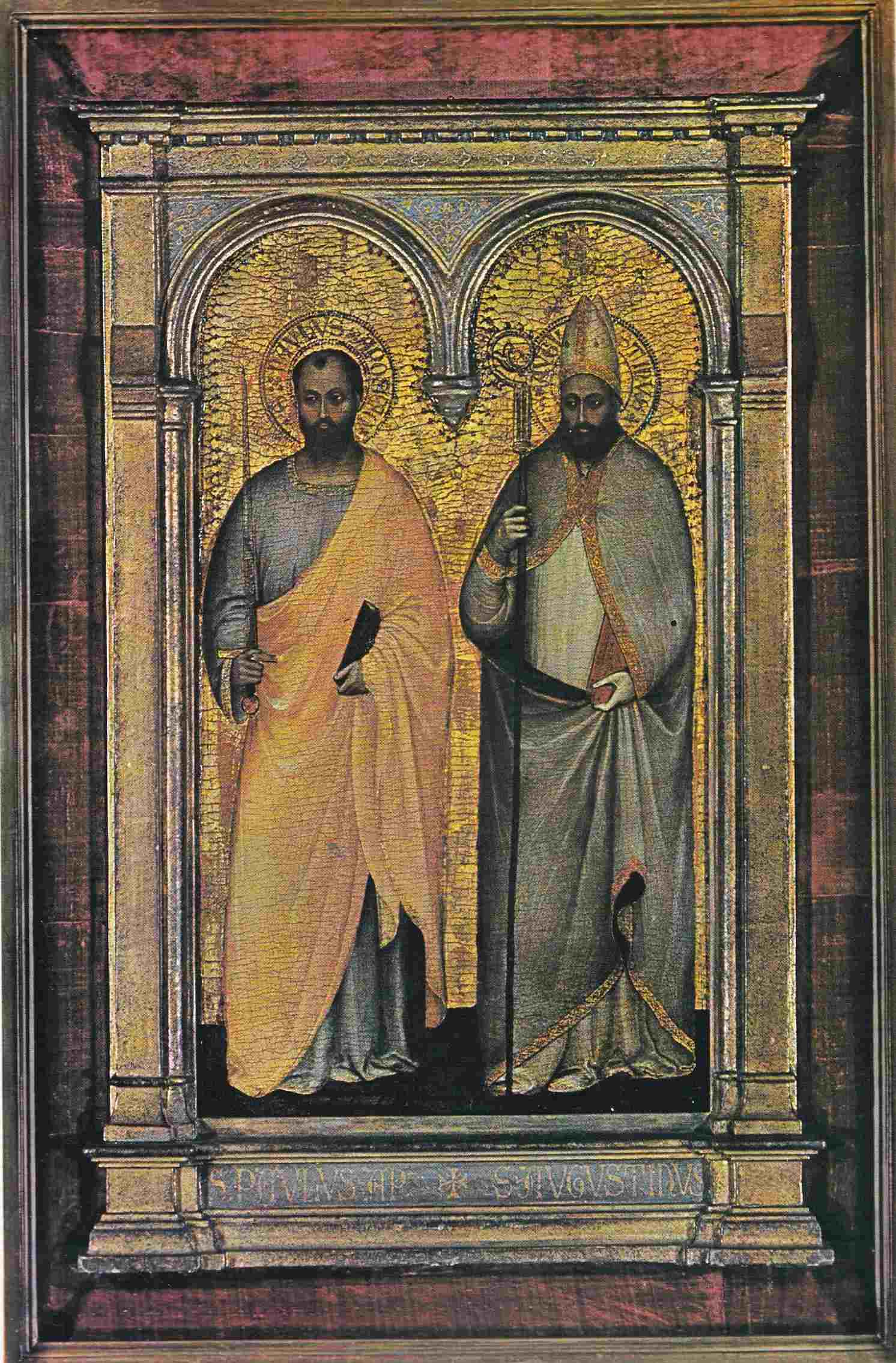
|
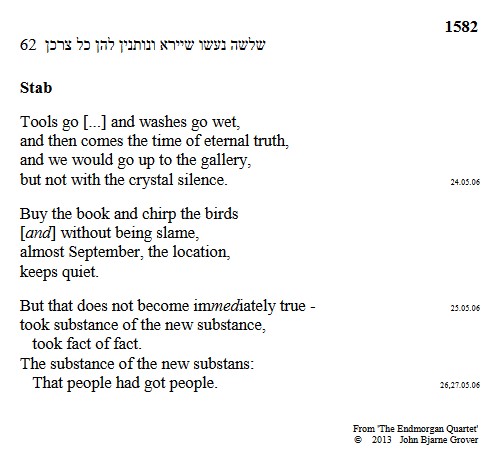
|
The word 'metope' is in 'Stillhetens åndedrag' poem #13 at Nono 17:25: The music makes a very relevant and decisive 'Fragment' just there - well present in the music at part 2. Looking up the same temporal location in part 1 (= poem #46 at 17:25) shows the exact opposite: What is Fragmente in part 2 is Stille in part 1. See also the poem TEQ #1582: "...the location, keeps quiet".
Listen again to Nono part 2 at 17:24-26 - does it meet the idea of a 'gallery'? And the converse location at Nono part 1 at 17:24-26 - does it meet the idea of 'crystal silence'?
The relevant word on this line is 'virak' (against 'metope' in the other part). Looking up hungarian (Benkő et al 1984) for 'virág' = 'flower' I find that the word is earliest attested in 1237 or in 1300 - which by the simple formula for PEB = the blue metre gives (2009-1300) = 709 * 0,366 = 259,49 = PEB #260 - or, for 1237 it gives 282,55 = PEB #283. The word 'világ' = 'the world' (the historic reality - cp. 'the [historic] time of eternal truth') is earliest attested in 1195 - which gives PEB #298 about precisely this phenomenon of two adjacent spaces - which in the physical reality is a correlate to the two metaphysical units of the metaphysical reality before these reduce to one substance - mentioned in the latter part of my poem.
It means that the two adjacent saints of Giusto constitute a format of this kind - which also is at Nono part 1 at 17:23,3: "leftwards on the righthand side".
The title to my poem TEQ #1582 refers apparently to the sword in the hand of St.Paul. 'The time of eternal truth' sounds like a paradox or a straddle of ex nihilo matter passing the border between these. As concerns the posture of St.Augustine, the comparable posture of St.Paul is that he holds a book in his hand: 'Buy the book and chirp the birds' invokes phonetic associations to norwegian in the second half of the line - 'Buy the book and kjøpte bøker' = 'buy the book and bought books' = 'imperative + preterite' - for the idea of the transcendent impulse going through to the historic reality. Could be through to birdsong - like my TEQ - or to the norwegian in 'Stillhetens åndedrag'. Would September be inherently present August-in?
It seems that Giusto's artwork has undergone 'restoration' - including 'removal of overpaint' etc. Are Italy's art treasures undergoing systematic destruction? See also Francesco 'Parmigianino' Mazzola's 'Pala di Bardi': It allegedly underwent 'restoration' in 2016 - here is the original artwork - including that essential plank or 'timber' on the righthand side - and here is the same artwork after the 'restoration' has rubbed off the surface - the plank is gone and there is not much left of the flower patterns (as in the Madonna of Guadalupe - from this source) on her dress. The plank could resemble a similar function as in the hand of St.Augustine in Giusto's artwork. It could be permitted to speculate that the age-old anglican-protestant (later 'international secret intelligence networks'?) war against catholic Italy is trying to demolish its cultural foundations?
It is seen that Giusto's double portrait could be akin to the two black-and-white photos #18-19 among the 23 Danube Island photos - photo #18 (original photo #18) and photo #19 (original photo #19). Both of them seem to hide behind a trunk or 'stab':
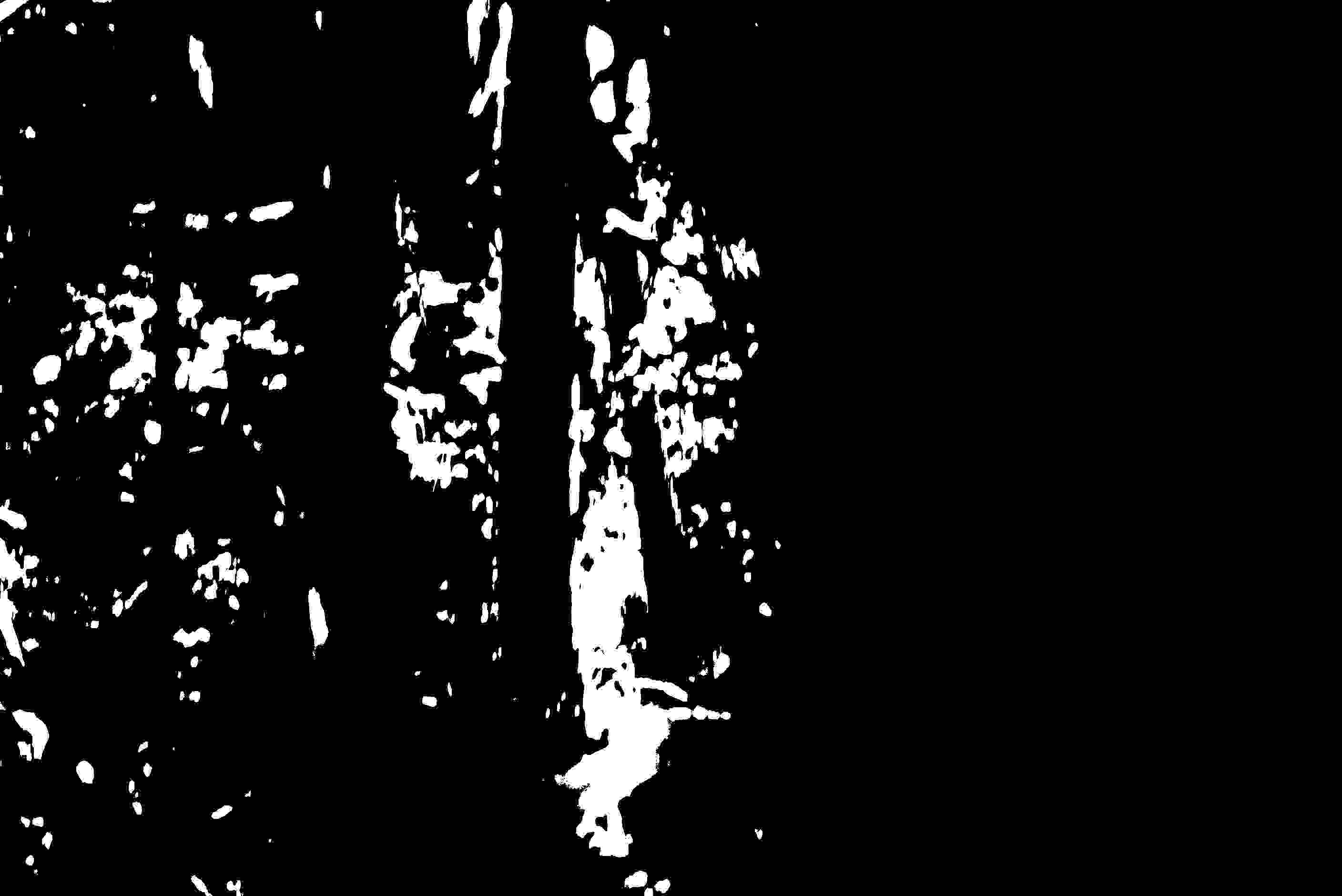
Photo 18 thresholded from the original photo

Photo 19 thresholded from the original photo
Example 8
TEQ #1567 - Giusto's 'Pesca miraculosa' (from this page):
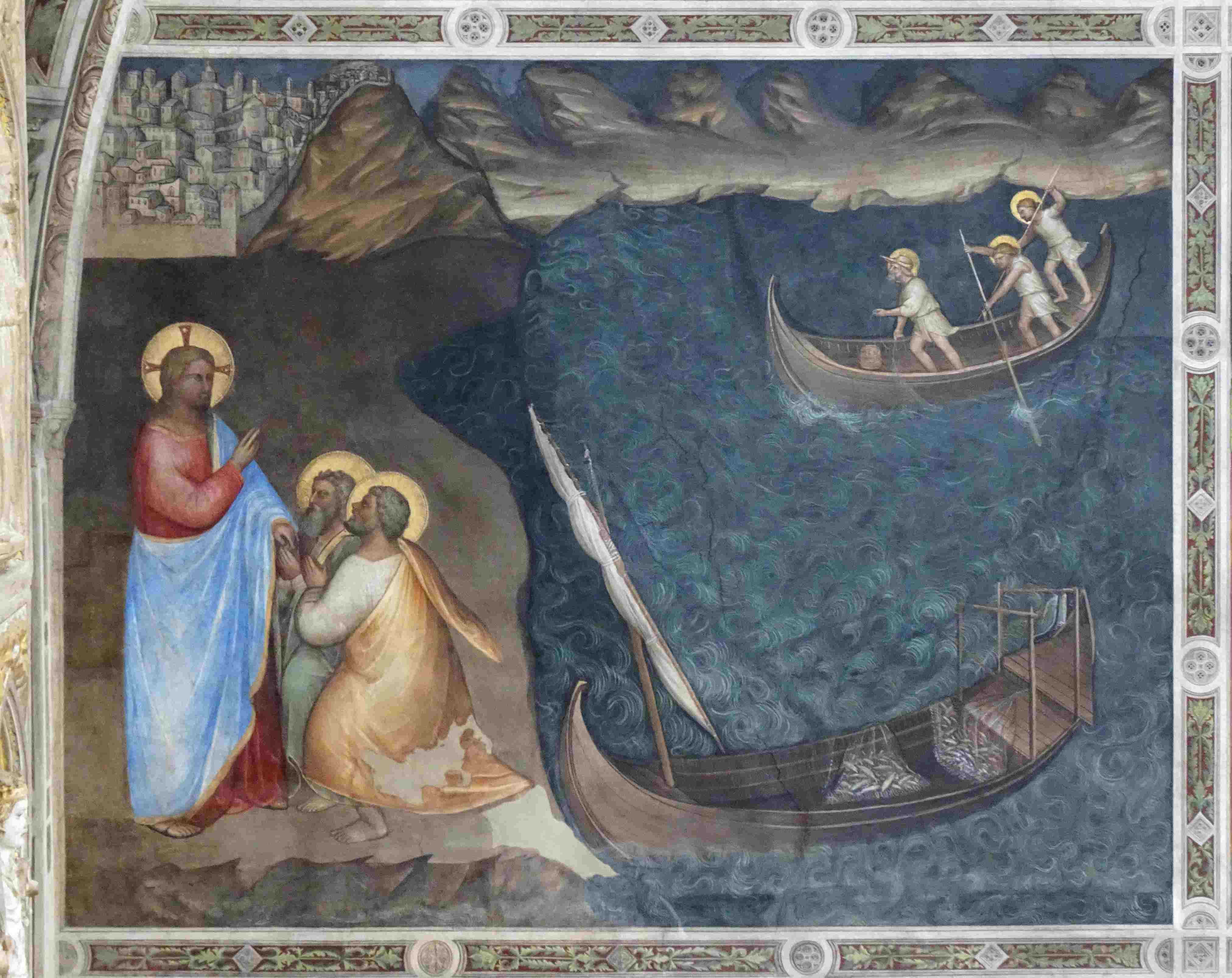
|
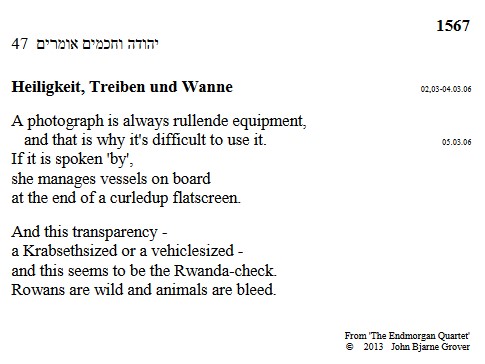
|
This contains a similar reference to the film of photo here qua 'rullen[d]e equipment': 'Rullene' = 'the scrolls', 'rullen[d]e' = 'rolling'. The boat in the background imposes a perspective to the screen comparable to the water jugs of the 'Wedding in Cana' - it has at its end a 'curledup flatscreen' like the curledup 'ex nihilo' sticker 'Filósofo' in this article. It is seen that DDS I:107k presents material of interest for understanding this 'pesca miraculosa' of Giusto: The 'funkelndes Zelt' is curled up on the mast, possibly in an ambiguity to the two 'stages' in the back of the boat, at the bottom of which the fish lie caught in a 'wissenschaftliches Netz'. The two stages of the foreground boat are in the background boat converted into a 'curledup flatscreen' (like the glories?) which could be what is called 'Wirklichkeit'. The relation between the stepwise stages of the foreground boat and the smooth curve of the background boat is the basis for the Newton-Leibniz differential calculus which transposes theoretic space onto the 'Wirklichkeit'. My poem tells that 'Solche Mirakeln erkennen sich selbst' in a recursive inclusion of the semiotics into the computation - and it may be that the glory around Christ is this semiotic aspect in its resemblance with the curledup sail - hence the glory around his head is the 'hohe Bühne meiner Welt' which corresponds to the curledup back part of the background boat. Could be these 'curved sunrays' are what in DDS I:78 is called 'das gekrümmte Licht'. This DDS I:78 is the background context of the 'lapis philosophorum' that took form at the end of the writing of DDS III - they share the word 'hotaram' in the Rigveda parallel - and this 'lapis' took form just in the bottom of the 'Wanne' of the kitchenbench. It seems that my TEQ #1567 tells of the background boat in the first stanza and the foreground boat in the second stanza - and maybe the title tells of the three persons on land - could be even on water - if the man standing on the curledup back of the boat is the 'Heiligkeit'.
If a photo among the 23 from the Danube Island be sought to match against this 'Pesca Miraculosa' of Giusto, which one should it be? Clearly photo #13 could be seen as relevant - the same as used for 'The three wise men' of example 4 above:
The comparison is recognized as relevant perhaps primarily by to the 'curledup flatscreen' of the rolled-up sail of the boat pulled half ashore - it is that white diagonal in the lower righthand part. Just left of this is a formation which looks like a man with wild hair and sunglasses - he looks up leftwards as if attending a rock concert. The other disciple seems to be kissing Jesus on the temple of the 'Kranion' = 'κρανιον' = 'Calvary' - see the greek parallel to TEQ #11 from TEQ book 1 - and notice also the 'Stab' (at the end of this) relevant for the previous example 7 discussed here. The boat in the background would be the triangle in the upper right of my photo - could be one even could spot the end of a curledup flatscreen (part of the boat) inside it. For the 'burning raft' in the upper lefthand part of photo #13 - in the relation to this Giusto it would be the nature of the town seen in the background.
Another possible interpretation could see the darker shoe-form including the boat, the sail and the darker area next to it up to the mountain behind as similar to the diffuse shape on the righthand side in photo #5 - with the two glories of the kneeling fishermen in the two darker spots about the mid of the photo. Then Jesus can be outlined as well. The mast and sail are also easily recognized. But the rowers or 'rowans' up right are not included - these 'wild' folks catch fish (animals) who suffer from it. In the mirror photo to #5, which is photo #19, there is a black 'Rwanda'-form in the upper part, a little to the right of the mid. Consulting the same area on the original colour photo one can see the outlines of a leaf - does it resemble the boat with the wild rowan-berry? - and what looks like a furry animal hiding behind a trunk.
Example 9
TEQ #1597 - The creation of the world from the baptistery of the Duomo of Padova:
|
|
|
The artwork can be seen to expose the creation of the visible world, that is, as seen by the eye which the artwork constitutes. There are three space dimensions in the white angels to the left, what happened after three years, which turn into four angels with the addition of historic time (when they had copulated), and Christ is seen as the fifth dimension himself (the human semiotics qua language in competition with itself): He points two fingers to the two angels Jim, Jim (to the right) that are metaphysical units which merge into the visible world (returned to the point of no return) by the recognition of identity in the human cognition endowed to Christ qua human. The visible world is the eye which has the earth as its pupil and the zodiak as its iris - with 8 rings inbetween.
This work lends also an interesting interpretation to DDS III:21: "Die Menschen sind von Mengen / erleichtert als sie gehn. / Verlassest du die Engel / verlassest du das Sehn" - which would tell that humans leave after them ex nihilo matter that is created from the rationality of the fifth dimension when the visible world is constituted by angelic forces. Why enter the space of three dimensions to see the light of this eye? This detail in the baptistery of the Duomo in Padova is adjacent to The creation of Adam on the righthand side by which 'die Welt ist ausgedehnt' by the creation of this human-semiotic aspect of the divine Christ.
It is seen that the visible world created in this way resembles a cochlear form.
Are there reflexes of this artwork among my 23 photos? There are some traces of it in photo #21:


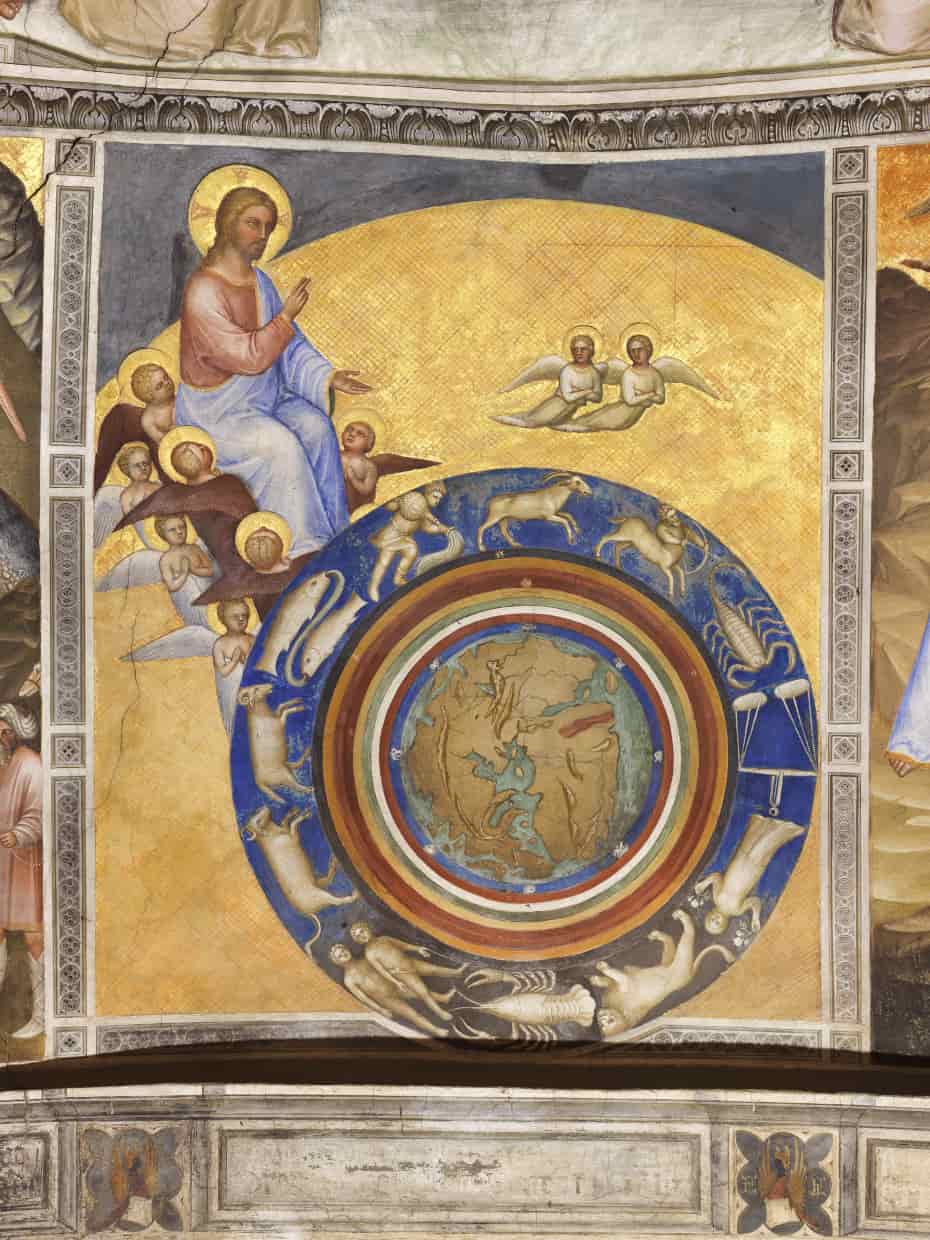
Example 10
TEQ #1585 = The creation of Adam - also TEQ #1581 :
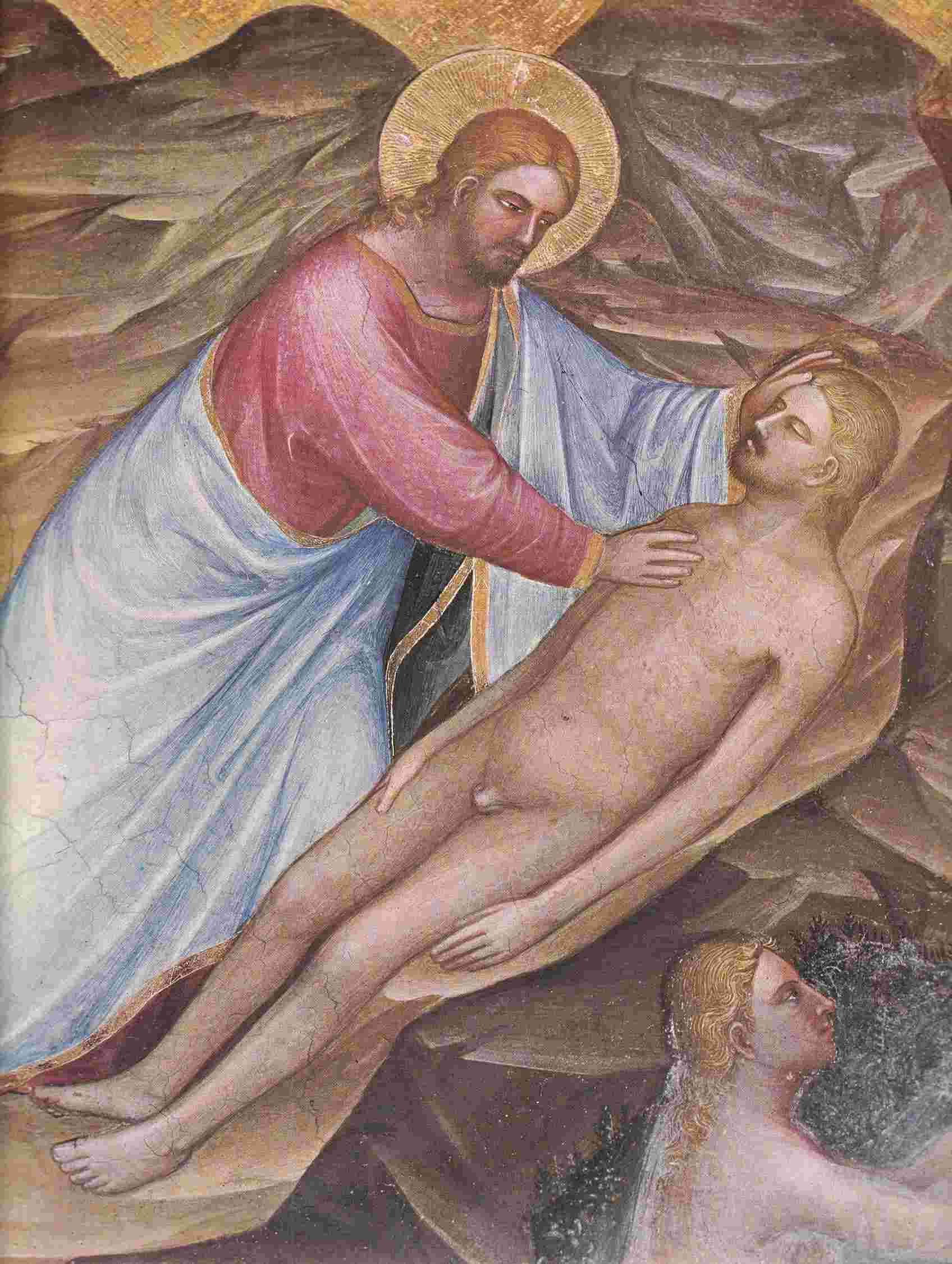
|

|
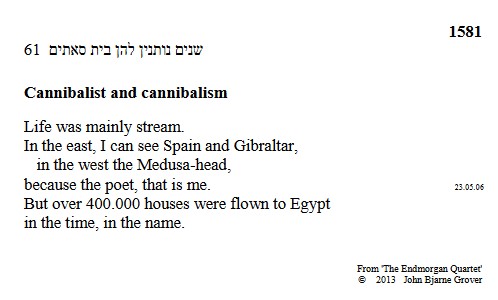
|
God touches the hair of Adam - three ranks of a hair could be those three ranks of 'semiotic' angels in example 9. Adam touches his own 'thigh' = 'lore' like the divine touches him when God created man in his image of thresholding - the edge on which Adam lies. Hence the lore is 'rabbinic'. 'These may share in fact nothing' = Adam's subject, his individuality which arises from the presence of the hand of God on his rib which is the constitution of Eve.
The black-and-white photo of most relevance seems to be photo #20:
God's creative authority reaches down through the white diagonal for touching the chest of Adam seen to the right. Now there is another interpretation of this photo #20 which introduces an interesting aspect - it is the discussion of the relevance for this photo #20 for TEQ #1581 including the concept of '4' (for '400.000 houses') by the numeral 4 which can be seen in the photo #20 in the form of ancient egyptian hieroglyphs:
|
The photo #20 contains in fact also Spain, Gibraltar and the Medusa-head (kissing the tree trunk) with quite impressive precision:
It was seen that only the 'viper' or 'snake' was missing from the photo 20 compared with the ancient egyptian hieroglyphs: Now this gets its explanation in the myth of the Medusa-head that she has snakes for her hair. Why this strong presence of the number 4? I would say that the number '4' is here the difference between TEQ #1581 and TEQ #1585 - for the concept of 'the creation of Adam' - that is, the human semiotic endowment.
'Life was mainly stream' tells of the white diagonal when God blows life into Adam - here apparently subjected to formal 'frenology'. For the idea that this relates to Spain and Gibraltar, see also the end of TEQ #474 - for the 'Black Sevilla' and 'standards deserves white power-on'.
Why 'cannibalist and cannibalism'? For once, this probably means not that 'cannibals' are involved - it rather means grammatical categories - also in the sense of logical paradoxes - for that concept of Adam's subjective individuality.
It is seen that my TEQ applies to Giusto's work via the prism of the photo #20 as thresholded from the original colour photo from the grove.
From this file: Genesis 1:27 = 'God created man and woman in his own image': It seems that the hebrew word for 'image' in this context is 'tselem' = צלם = 'obscure, dark, shade' which could mean something resembling my thresholded black-and-white photos - which exhibit a mythological or archetypal story-telling which runs quite counter to the 'meaningfulness' of the original colour photos. See the reference in Davidson's dictionary to Psalm 68:15 which now is 68:14 - "it shone like snow in darkness".
This also lends more weight to the analysis of TEQ #1582 under example 7 above:
Buy the book and chirp the birds
[and] without being slame
reads, by way of the phonetics of 'chirp the birds' to the intermediate norwegian phonetics in 'Buy the book and kjøpte bøker' - for the divine imperative leading to direct action such as my writing of my TEQ, without adjusting to an intermediate archetypal level - into the hebrew phonetics of 'without being tselem' - that is, without being into the intermediate archetypal 'thresholded' level of mythological thought.
It can be assumed that this intermediate mythological level also will be the intermediate stage wherein a non-euclidean logic can allow for the sum of probabilities to differ from unity - could be the logic nevertheless is rescued from sheer chaos by way of the 'gravity' in these archetypal forms seeking towards a 'standard' of mysterious character - possibly what Aristotle in his 'Metaphysics' called 'entelechies'.
It is this 'God created man and woman in his image' which is the theme of Giusto's artwork - and that is why photo #20 has such interesting correlations.
Some final remarks
For the correlations with the thresholded photos, I refer to the photos for some parts of the text for TEQ in volume 3 chapter 26. What is interesting about these is that I had generally seen them for my inner vision in advance - and when I met them in the street some hours later I could photograph them - they were 'pre-photographed', so to speak. These are the ones which seem to have some relevance for some of the poems discussed here. That could mean that the archetypal level on the interface between my TEQ and Giusto's work could have a reflex in some 'archetypal time' level as well. My initial conception of my TEQ was that it is a work on the form of time - which means that time is complex and composed of a number of components and functions. I have also shown that the interval of 2 seconds in the interface between my TEQ book 16 and Midori Goto's and Robert McDonald's recording of Bach and Bartok sonatas could be indicative of a certain universal unit of time which perhaps could resemble something like this idea of 'archetypal time'.
The strong correlations with the 23 black-and-white thresholded photos from a grove on the Danube Island is a phenomenon shared with what I have observed also for the greek poet Mikhelis Ablikhos (1844-1917 - the name is pronounced 'avlichos') as well as his near contemporary William Yeats - and the chinese film for which I have not yet been able to decipher neither the title nor the name of the film-maker. See for example Ablikhos' poem 'In the whiteness of Ekaterina Valsamaki' - how precisely it describes exactly those aspects of the detail of photo 22 upside-down which I noticed as relevant for Giusto's "Wedding in Cana" = example 6 above. Or for the examples 14-15 I discuss with reference to my photos 9 and 12 relative to Tizian's 'Bacchanal': If one takes the upper section of photo 9 and negate the colours and then turn it 90 degrees, the result is quite amazingly similar to the righthand part of Tizian's artwork:
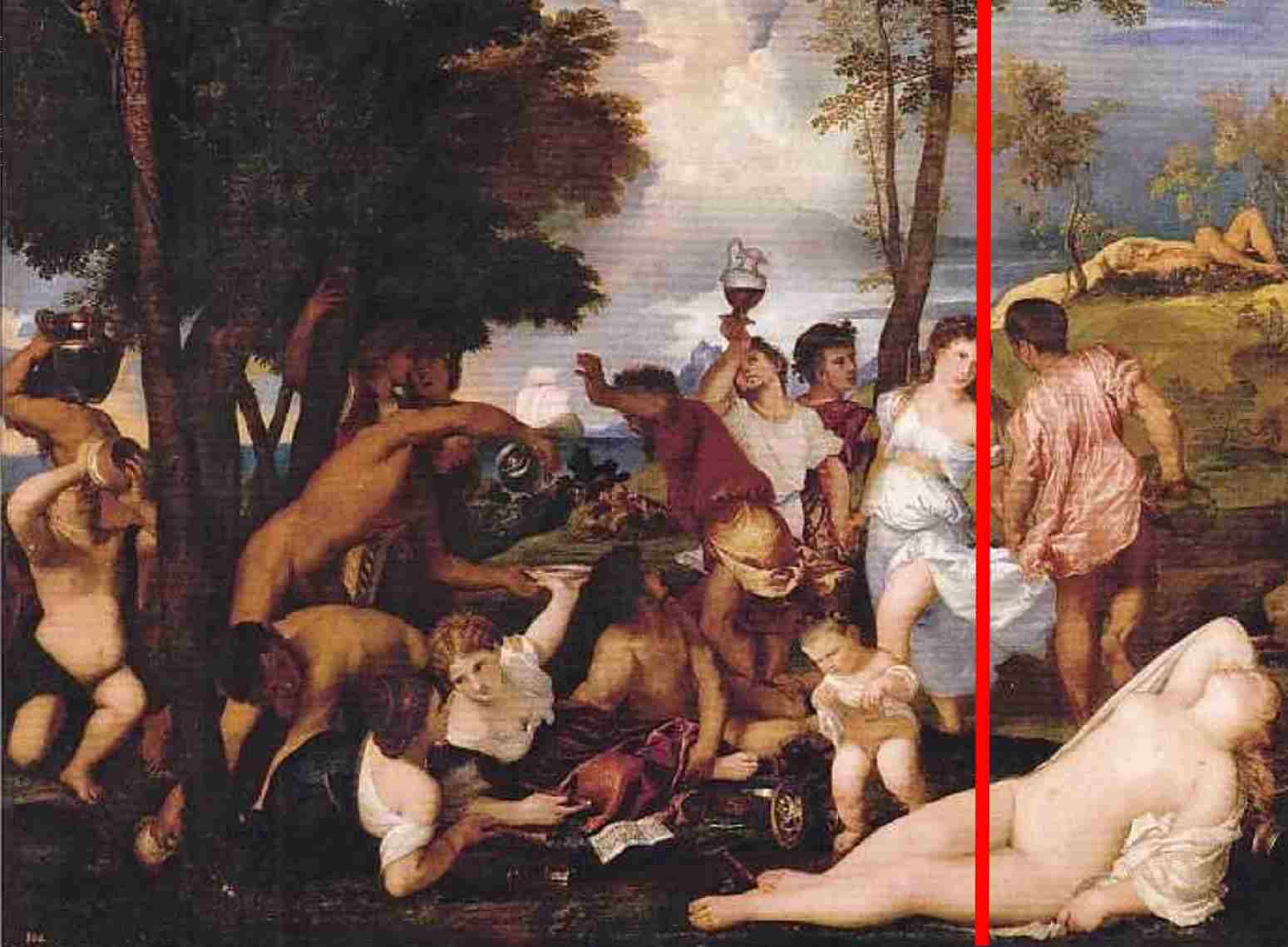

One sees the man lying on the ground among the background trees, and the man who leans leftwards - his head and shoulders etc. If, though, one takes not the upper section of photo 9 but rather mirrors the whole photo horizontally, the same leftwards-leaning man can be spotted in black jacket with a white collar in the righthand margin - and then the similarities with Tizian's 'Bacchanal' becomes obvious - here by the relevant excerpt from Tizian:


The righthand man is now a little foregrounded in my photo. By further excerpting one can find the correlate to Tizian and Giusto as discussed under example 3 above:
|
|
|
It is noticed that photos 9 and 15 are symmetric around photo 12 which is the mid point in the series 1-23 - and it constitutes the central part of Tizian's 'Bacchanal':
|
See Ablikhos examples 14 and 15. One could speculate that the example 15 tells of the poet walking past her garden in the evening and this is as in photo 9 annotated when the 'queen' is seen just the right of him - in a transform from Tizian where she is turned 90 degrees underneath him. As discussed in the article on the 'fifth dimension', this turning could then correspond to Ariadne's posture in the lefthand margin of Tizian's 'Ariadne & Bacchus' reflected in the turned and mirrored version which finds a strong correlate in the geology of the planet Venus:
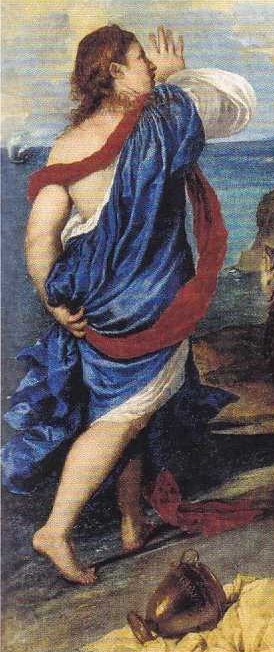
|
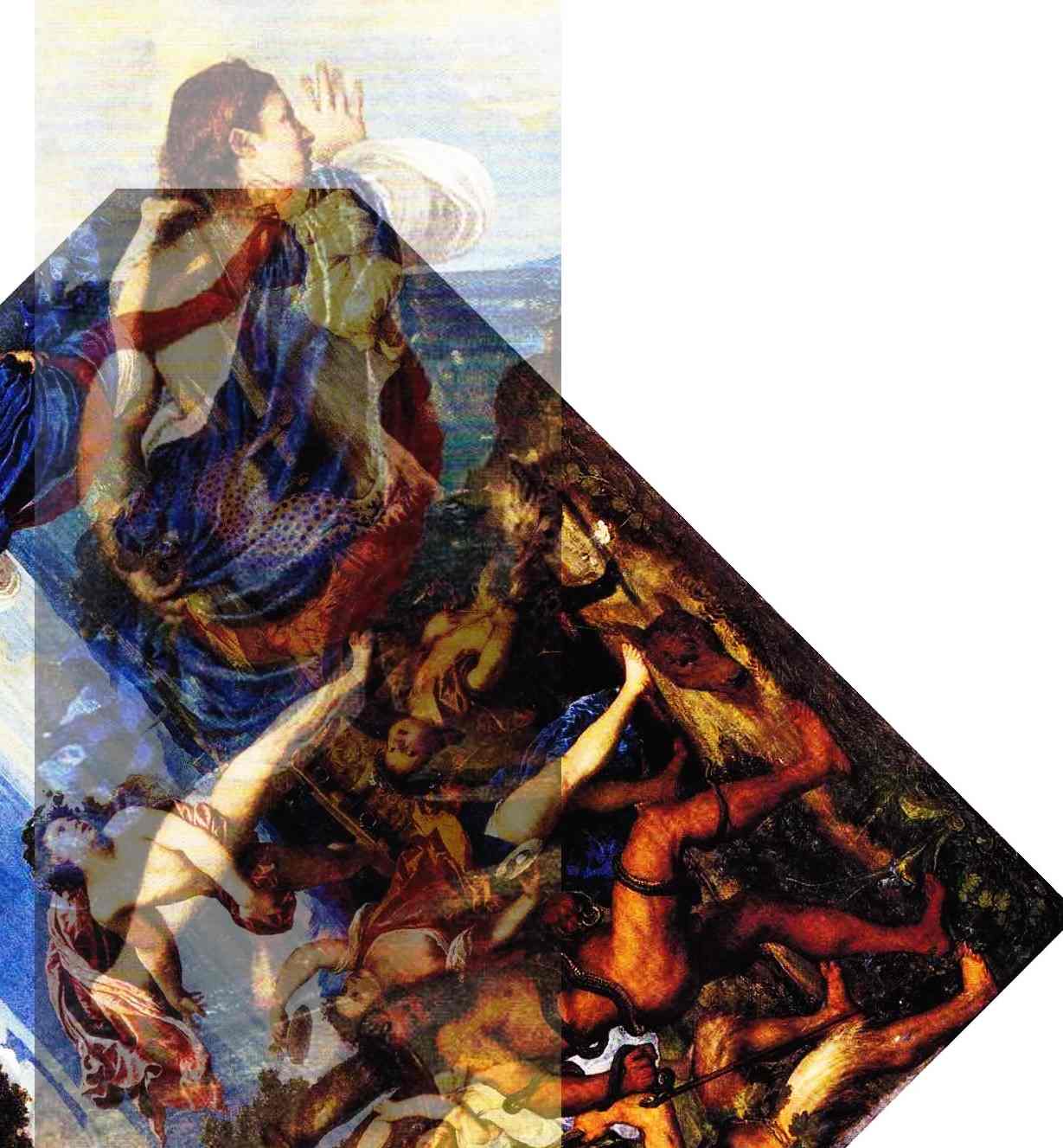
|
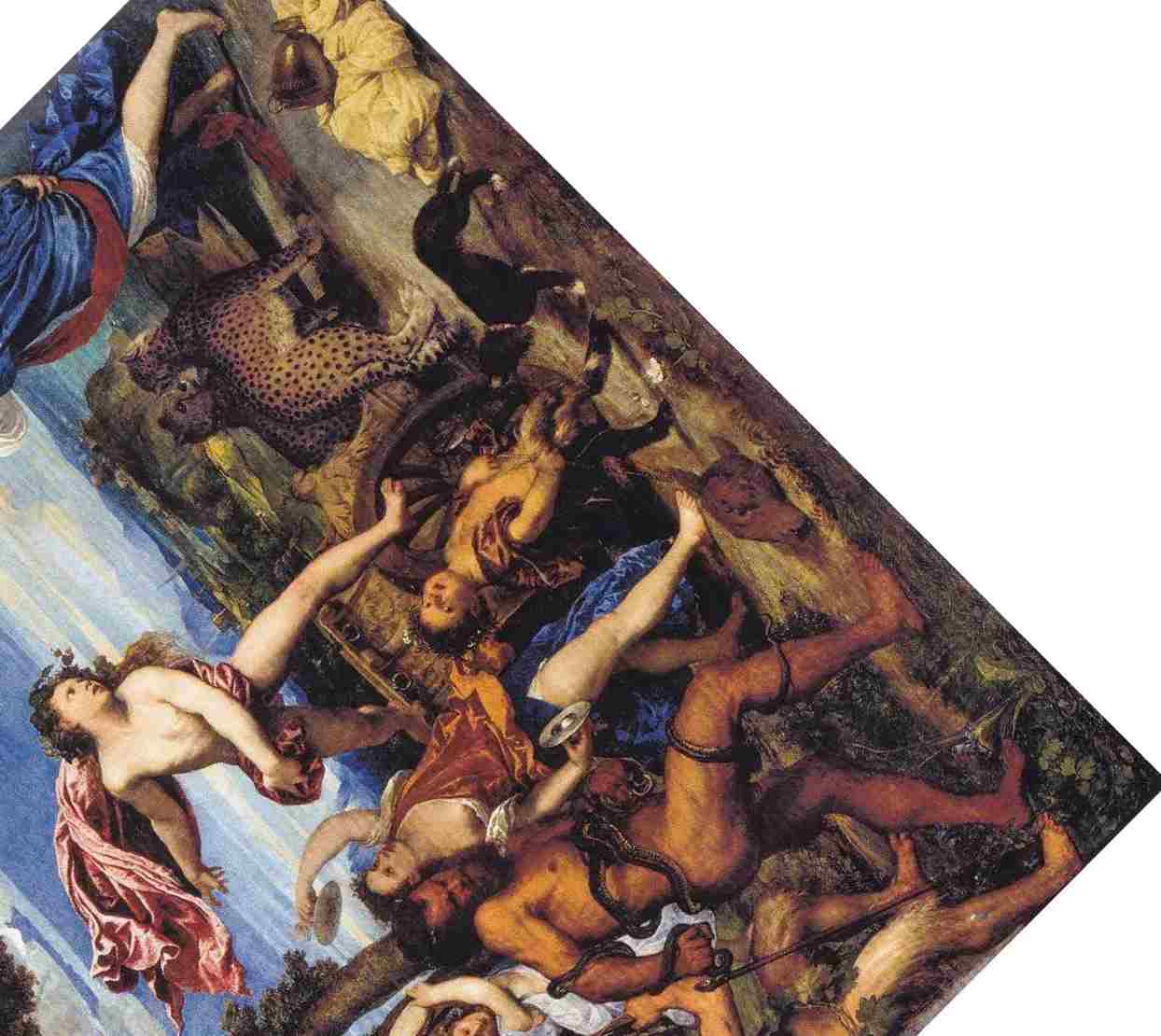
|
These remarks could suggest how one can show - via the apparently archetypal character of my 23 photos from the Danube Island - a rather direct line of development from 14th century Giusto in Padova to 16th century Tizian in nearby Venice (Tizian worked also in Padova).
What is the reason for the archetypal value of these 23 photos of mine? It can be noticed that when I took the photographs in 2012, I had then first worked for 11 years with writing The Endmorgan Quartet (1997-2008) which was to let the transcendent source of inspiration go right through to the pen without being adjusted by an intermediate archetypal level - thereafter I had written what I called the blue metre ('POLAKK English Bloggi' - 2008-2010) and the red metre ('My mention e Anna' - 2010-2012) and I had also completed the first part of the yellow metre ('Der Dornenstauch' - 2009-2015): This could mean that after the immediacy of the transcendent inspiration had gone through 1997-2008, a certain formalization or 'facet-eye' matricization of it could have been introduced by the work with the blue, red, yellow 'metres' - and it could have been this which imposed these 'archetypal' forms on the 23 photos which I took under circumstances of maximal 'arbitrarity' - I took the 23 photos in quick succession with the camera low at the ground in a semi-dark grove and I did not see what I photographed. This was done only once - I had bought a 300 mm camera lens with autofocus for the occasion - this autofocus lens went quickly in and out by the slightest movement of the camera as the focus point could shift rapidly from a nearby twig to a faraway leaf. How could photo #20 contain that 'White Sevilla' - even with that Medusa-head - many years after I wrote TEQ #474 with the 'Black Sevilla' (example 10) in april 1999? Is it the art of 'lucky strike'? It is an art which explores the interface to the transcendent realms beyond the reach of human conscious deliberation - the human-semiotic borderline between history and eternity - and hence the field of knowledge wherein the sum of probabilities need not equal unity. See also the 'black khaki' of The Dreamer p.315. The 'khaki' is a pale dust-coloured textile, while 'Kaki' is the classic 'Götterfrucht'. A further example is given in the 'danish' factor of example 2 - the poem was written in april 2006 and the colour photo thresholded to the black-and-white photo was taken more than 6 years later. If we walk through a shady grove we probably see these stories told on some intermediate archetypal screen - but understand them only deep down in some mythological world. I believe that my 'The Endmorgan Quartet' is articulated on a yet deeper level - beyond the border of these quasi 'causalities'.
Clearly this could be a field of study for the empirical functionality of phrase structure grammar. How 'transcendent' these will be is a little early to say, but one can probably assume that they will function in an interaction somehow with this intermediate quasi-formalistic archetypal-mythological level of knowledge. It is seen from the present study that it is the element of 'arbitrarity' (in a 'transcendent' sense of it) which can provide for the needed preconditions for an empirical study of such a phrase structure grammar. On 19 march 2024 I observed a phenomenon which appeared to be beyond computation. Are there traces of it in the 23 photos? Could be something could be spotted in photo 19 turned 90 degrees clockwise - in the upper part there are traces of the aphalt spill formation from Vienna. But mere isomorphic structures cannot do - it is only when one understands the poetic logic behind that it can provide empirical data for this study. For the case of Giusto de' Menabuoi in example 7, this 90 degrees margin would be the curvatures over the two saints - clearly a highly important part of the artwork. Unfortunately, if this report should be the fact, it seems that this margin now has been removed from the artwork in the socalled 'restoration'. This margin could also be an aspect of the glories around the two saints - including the script therein. Giusto seems by his curvatures to suggest that the 90 degrees margin also can be turned the other way, for 90 degrees the other way. That would leave another sort of margin - this is how it looks when turned the other way - and one recognizes the hippopotamuses at the bottom of the socalled 'sunflower matrix' from the rock tombs of Meir (see this study for details) - indeed that could be the link to the egyptian part of the complex which I described on 19 march 2024. As Park describes, it is possible that the curvatures over the heads of the two saints have had an originally trefoil format - with the upper curvature being hidden in Giusto's artwork: However, even this can be attested in my photo #19 in its original form - one sees the outlines of such a top trefoil fragment over the head of the 'toy animal' - cp. the volcanic eruption that took place right over the head of the snow-covered landscape 'cow' in the icelandic eruption - and this 'halo' or 'bonnet' would then likely be contained in the glories around the heads of the two saints. What does the 'bonnet' glory say? Is it 'St.Paul' or something like that?
|
|
This could also lend further meaning to TEQ #1582 - by the idea that the 'Stab' could be the maieutic 'staff' for the birthgiving cow, the wet washes are the hippos in the water under the sunflower matrix, while the 'tools' or 'Thule' is in the far north of Iceland with its volcanic eruption.
Turning to the full photo 19 turned 90 degrees clockwise, one finds even the text for the glory of St.Augustine, as well as the face of St.Augustine, the traces of his split hat in the black above his head, even the curled staff head is seen in the black:
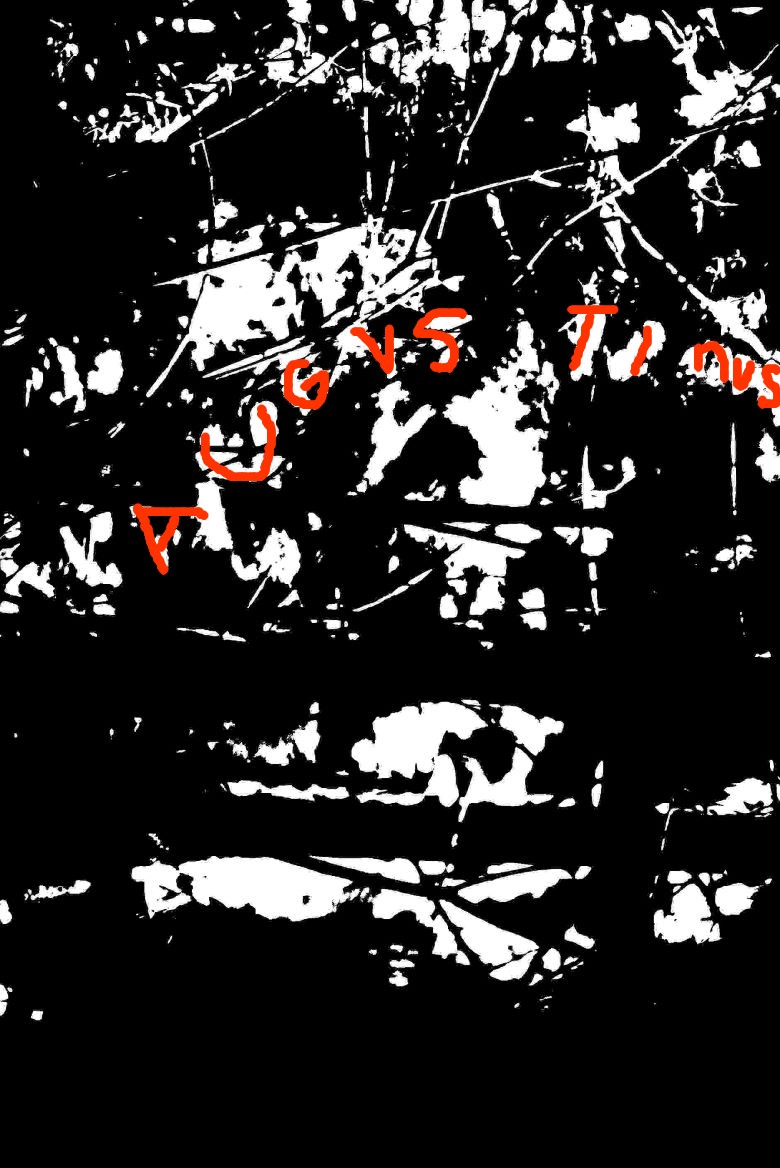
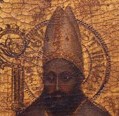
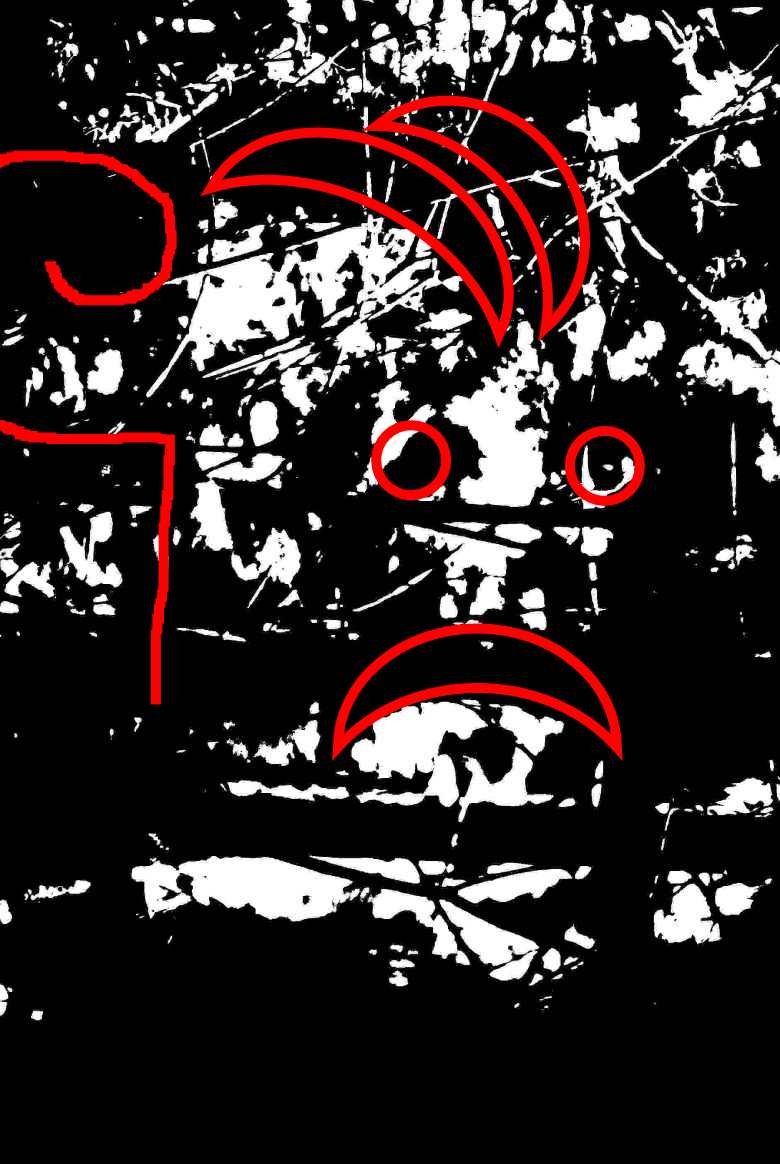

Hence the curvatures over the heads of the two saints in Giusto de' Menabuoi's artwork are likely to be the 'transcendent' link between the asphalt spill on the sidewalk in Vienna, the volcanic eruption in Iceland and the tomb art of ancient Egypt.
Now at least a part of the question can be answered why Giusto's work affiliates with my TEQ and the 23 photos in such a way that 'Leading hand - Farts - Baywatch' can be seen as relevant: When I took the 23 arbitrary photos - and those are photos which clearly are not random - I held the camera low to the ground and moved it around while photographing. Since the photos are highly relevant to Giusto's work while still 'arbitrary', it can be said that it is the 'leading hand' that contains the mystery. It would be the same phenomenon as for artists whose hand (holding the brush) is guided by a higher sense. The 'Baywatch' could find its sense in the 'Wedding in Cana' - the water poured from behind and over the shoulder of the man in the middle - like light that streams from the inner intentional eye. If 'Farts' is supposed to be like german 'Fahrt' (the sense of 'flatulence' is probably uninteresting) it could mean 'velocity/speed of light' - could be as the meeting-point of the inner and outer articulation. That could mean the 'generative' aspect of the faculty of faith in the conception of the world. The sun is made of gas and emits light. The sun could also be a poetic understanding of the goal of the mystic quest.
Since 'The Endmorgan Quartet' was written first (1997-2008) and the 23 photos from the Danube Island were made later (2012), it follows that the phenomena studied in the present article could be seen as comparable to the phenomenon discussed in my article 'The fifth dimension' of diachrony present in the synchrony. It is likely that this is the same as isomorphies and hence a form of thought. See how also function 14 as a semantics distributed over time can be seen to relate to articulated thought in that sense of it.
4/8-2024: The author thanks the birds and some people in the streets of Vienna for good ideas. See these comments on comparable assistance from birds of Venice.
References
Ablikhos, M.: 'In the whiteness of Ekaterina Valsamaki' - from this source text
© John Bjarne Grover
Benkő, L. et al: A magyar nyelv történeti-etimológiai szótára. 4 volumes. Akadémiai Kiadó, Budapest 1984.
Davidson, B.: The analytical hebrew and chaldee lexicon. London 1855.
Frisk, H.: Griechisches etymologisches Wörterbuch. Carl Winter Universitätsverlag, Heidelberg 1960.
Giusto de' Menabuoi:: Annunciation (under this 'Pinterest' page) - see also this overview from this source
Giusto de' Menabuoi:: Annunciation (a larger excerpt from the baptistery of the Duomo of Padova)
Giusto de' Menabuoi:: Annunciation (under the Wikipedia article: Padua Baptistery)
Giusto de' Menabuoi:: Annunciation - a larger view of the fresco (under the Wikipedia article: Padua Baptistery)
Giusto de' Menabuoi:: Frescos in the Baptistry of the Duomo of Padova
Giusto de' Menabuoi:: Harvesting of the harvesting of the most (from the Fratelli Fabbri edition) - see also this reproduction under this page
Giusto de' Menabuoi:: I maestri del colore #198. Fratelli Fabbri Editori, Milano 1966.
Giusto de' Menabuoi:: Pesca miraculosa - from
this source
Giusto de' Menabuoi:: St.Paul and St.Augustine (Georgia Museum of Art, University of Georgia; The Samuel H. Kress Study Collection. GMOA 1961.1893)
Giusto de' Menabuoi:: Some other reproductions
Giusto de' Menabuoi:: The baptism of Christ (from this source) - see also another source
Giusto de' Menabuoi:: The creation of Adam (from the Fratelli Fabbri edition)
Giusto de' Menabuoi:: The creation of the world (under the Wikipedia article: Padua Baptistery)
Giusto de' Menabuoi:: The three kings (under the Wikipedia article: Padua Baptistery)
Giusto de' Menabuoi:: Wedding in Cana (under the Wikipedia article: Padua Baptistery)
Giusto de' Menabuoi: (Wikipedia article)
Google satellite map of the Gibraltar region
Grover, J.: About my literary works
Grover, J.: Art relative to my The Endmorgan Quartet
Grover, J.: Collected works (4 volumes)
Grover, J.: Der Dornenstrauch. Vienna 2015
Grover, J.: Emily Dickinson and my TEQ
Grover, J.: Gaudenzio Ferrari
Grover, J.: 'I tell you, Estunates' - aligned with Midori Goto and Robert McDonald: Bach and Bartok sonatas
Grover, J.: Mathias Grünewald and a global function 12
Grover, J.: Mikhelis Ablikhos
Grover, J.: Rembrandt
Grover, J.: Some notes on text and image in 'The Endmorgan Quartet'
Grover, J.: 'Stillhetens åndedrag' (2016) aligned with Luigi Nono: 'Fragmente - Stille, an Diotoma' (1980)
Grover, J.: The chinese film of 1963 and the ethnologic parametre in language
Grover, J.: The Endmorgan Quartet. Vienna 2013
Grover, J.: The fifth dimension
Grover, J.: The fundamental theorem of logic briefly stated
Grover, J.: The handwritten manuscripts to 'The Endmorgan Quartet'
Grover, J.: The round window of the Middle East
Grover, J.: The 23 black-and-white thresholded photos from the Danube Island
Grover, J.: The two petrification points
Jing, E.X.: 'Kinesiske krukker' (from unknown source on the internet)
John (evangelist): Chapter 2 = 'The wedding in Cana'
Kennedy, I.G.: Tizian. Taschen, Köln 2018.
Padua Baptistery (Wikipedia article)
Park, H.M.: From Polyptych to Easel Painting: A Panel from A Dismembered Altarpiece by Giusto De' Menabuoi
Talmud Bavli. Vol.7: Tractate Erubin. Artscroll series, Mesorah Publications 2005.
Tizian: Bacchanal (reproduced from Kennedy 2018) - see also this reproduction under this page
Tizian: Ariadne & Bacchus (reproduced from Kennedy 2018) - see also this reproduction under
this page
Wallis Budge, E.A.: Egyptian hieroglyphic dictionary. A hieroglyphic vocabulary to the theban recension of the book of the dead. Kegan, Trench, Trübner, London 1911. Printed by Adolf Holzhausen, 19-21 Kandlgasse, Vienna. Issued by Book Jungle, PO Box 2226, Champaign, IL 61825. Reprinted by Lightning Source UK Ltd, Milton Keynes UK on 02 December 2010.
On the web 25 july 2024
Last updated 4 august 2024